Winding cobblestone lanes, artistic haunts, endless cafes, and historic cabarets, all topped off with a basilica that stands proudly on the highest hill in Paris: Montmartre has long captured the hearts of travelers, and with so many wonderful things to do in Montmartre, it’s not hard to see why!
Once the home of artists like Picasso, Renoir, Van Gogh, and Matisse–just to name a few–visiting Montmartre today provides plenty of glimpses into the neighborhood’s Belle Époque past.
While Montmartre, or Paris’ 18th arrondissement, is one of the most popular places to visit in Paris today, that doesn’t mean that it hasn’t retained its magic–you just have to know where (and when) to look.
We’ve had the chance to visit Montmartre many times, including basing ourselves in the neighborhood on two separate trips, most recently for a full week.
Here is exactly what to do in Montmartre, from iconic views to hidden gems, plus tips for making the most of your visit!
Table of Contents
- Want to visit Montmartre the easy way?
- The Best Things to Do in Montmartre, Paris
- Fun Things to Do Near Montmartre
- Where to Stay in Montmartre
- Where is Montmartre in Paris? (+ How to Get There)
- Tips for Visiting Paris’ Montmartre Neighborhood
- Self-Guided Montmartre Walking Tour Itinerary
- FAQ For Visiting Montmartre in Paris
- Map of the Best Places to Visit in Montmartre
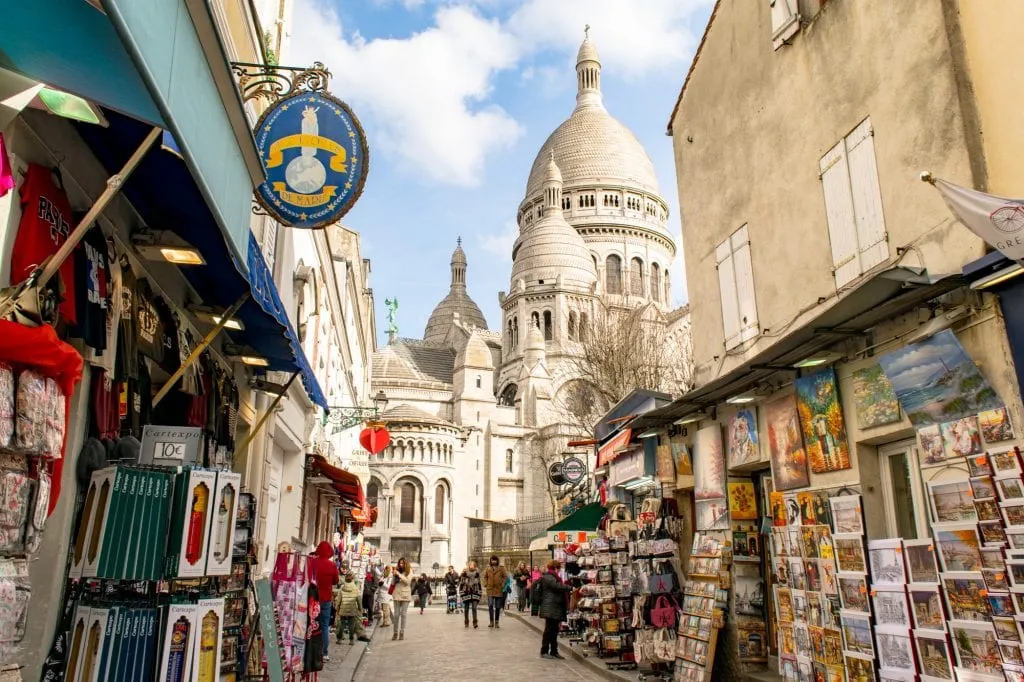
Want to visit Montmartre the easy way?
Only have a short time (say, half a day or less) to visit Montmartre and want to make the most of it?
This popular walking tour covers many of the most popular places to visit in Montmartre that we talk about in this travel guide (this is an even shorter tour option that also gets great reviews).
Opting for a walking tour instead of exploring independently does come with a few trade-offs–one of the great joys of visiting Montmartre is wandering semi-aimlessly around the neighborhood–but it comes with big benefits, too.
A knowledgeable guide with colorful stories can bring Montmartre’s bohemian past to life in a vivid way that is difficult to replicate on your own.
(… Without doing a lot of reading about the history of Paris in advance, anyway–for example, did you know that for a brief time in 1871, Montmartre wasn’t even part of Paris?).
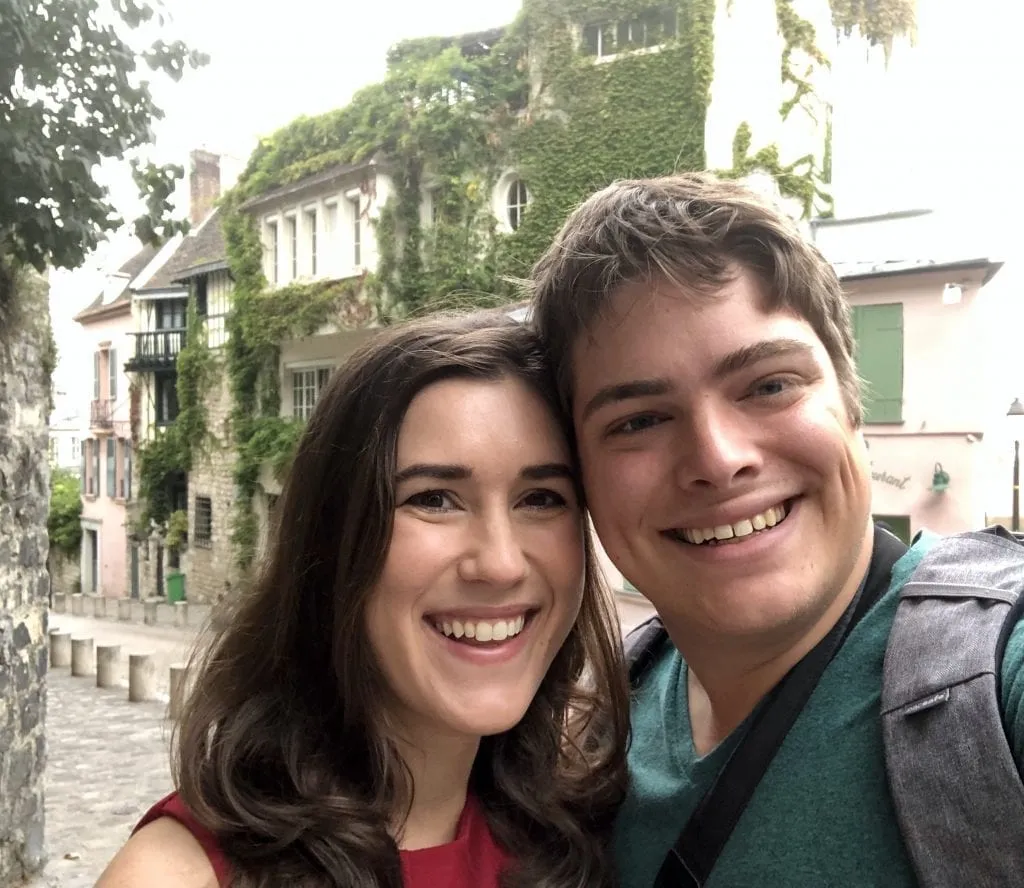
A walking tour also has the benefit of making sure you have a chance to enjoy Montmartre’s best angles without getting lost or climbing a few extra staircases in the process, which is easy to do.
If you do opt for a Montmartre walking tour, we recommend saving a little extra time before or after your tour to enjoy a drink at one of the neighborhood’s many outdoor cafes, and/or climb to the top of Sacré-Coeur, after your tour if at all possible.
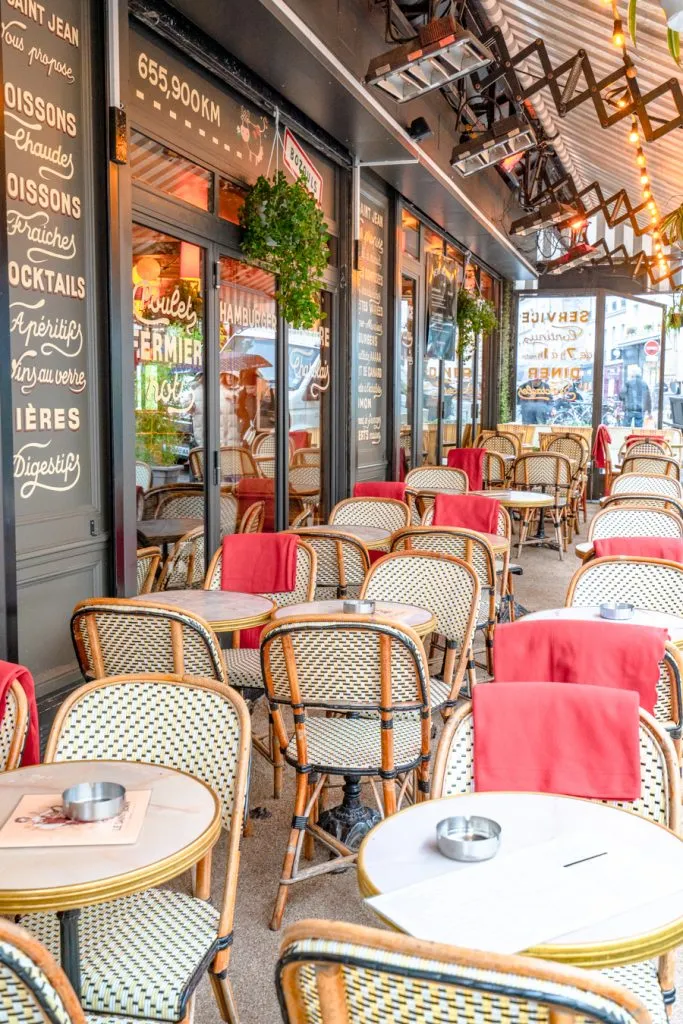
The Best Things to Do in Montmartre, Paris
Step inside the incredible Sacré-Coeur Basilica.
Standing tall at the peak of the Montmartre butte and visible from many of the best viewpoints in Paris, Montmartre’s Sacré-Coeur Basilica is a must-see when in the neighborhood!
The basilica itself is free to enter, and its Romano-Byzantine interior, complete with marvelous mosaics that remind me of a more modern Ravenna, is worth admiring.
Sacré-Coeur is newer than you might think, too!
Construction started in 1875 and was declared completed in 1923, a clear reminder of how ever-changing the Montmartre neighborhood is.
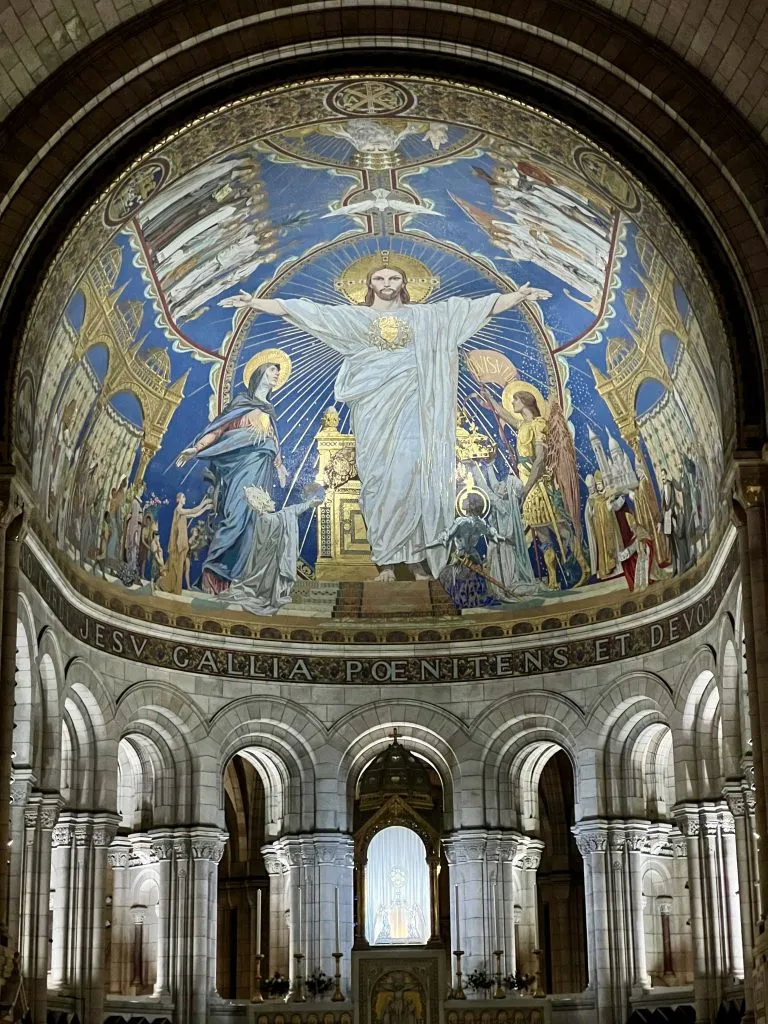
… and climb to the top to enjoy one of the absolute best views of Paris.
Climbing another 300 steps after already climbing all the way up to the base of Sacré-Coeur may feel a bit overwhelming (visiting Montmartre can be quite the workout), but it’s absolutely worth it!
While the view of Paris from the steps of the Sacré-Coeur is popular and lovely, the view from the top of the dome is stupendous.
The dome is open daily, but with different opening hours depending on the season.
You can check here for the current opening hours.
If at all possible, we recommend timing your visit to the dome for sunset, and be sure to leave yourself 15+ minutes to circle the dome (you can walk all the way around the edge of it) and enjoy the view!
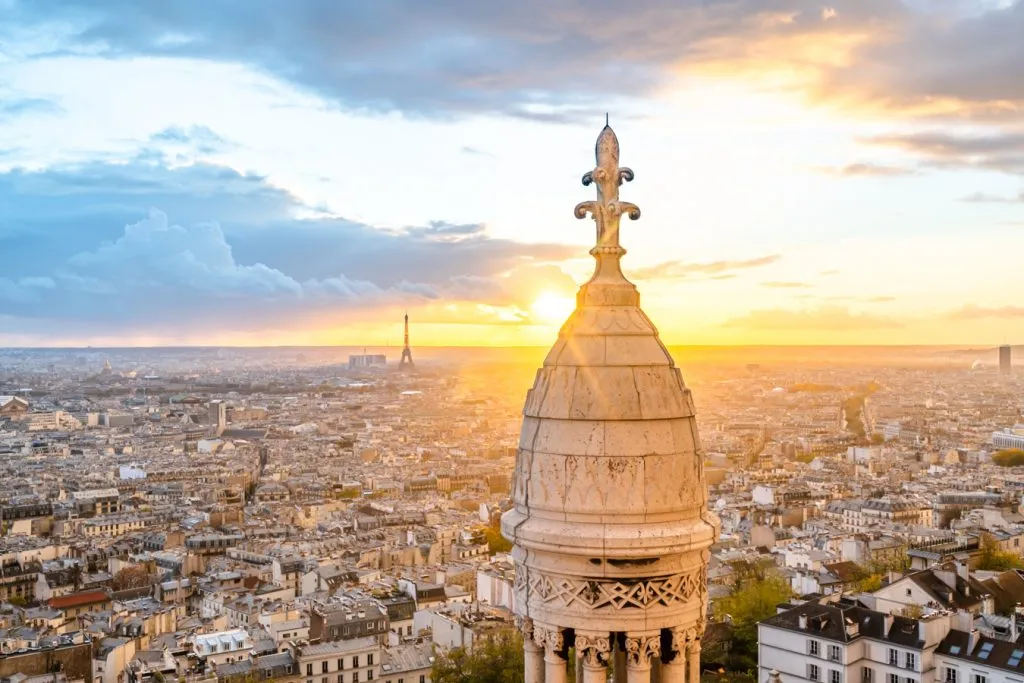
Admire Sacré-Coeur without the crowds at Square Marcel Bleustein Blanchet.
If you start circling Sacré-Coeur after enjoying views from the front, you’ll eventually come to the lovely Square Marcel Bleustein Blanchet, which is home to one of the loveliest views of the basilica!
This small park is located behind Sacré-Coeur, and thanks in large part to its location, is a delightfully uncrowded hidden gem in Montmartre.
From here, you can take a deep breath and enjoy gorgeous views without fighting for space or asking touts to leave you alone.

Enjoy the bustling, artistic atmosphere of the Place du Tertre.
Lined with picturesque cafes and covered with artists’ easels, the beautiful Place du Tertre is the heart of Montmartre’s artistic culture and has been for centuries.
If having your portrait drawn by a local artist is on your Montmartre bucket list, this is the place to do it!
The artists with easels set up in the Place du Tertre are licensed and regulated, and have to apply with the city to set up there–not just anyone can join.
For that reason, we recommend approaching a sitting artist if you’re interested in buying art here.
Roving artists who pitch their wares to you are not regulated, technically not allowed (though they always seem to be around), and much less likely to provide a product you’ll be satisfied with.
Regardless of whether or not you’re in the market for artwork, the atmosphere in the Place du Tertre is lovely and visiting is a great addition to a trip to Montmartre.
Don’t forget to turn back toward Sacré-Coeur for a view of the domes peeking up over the square!
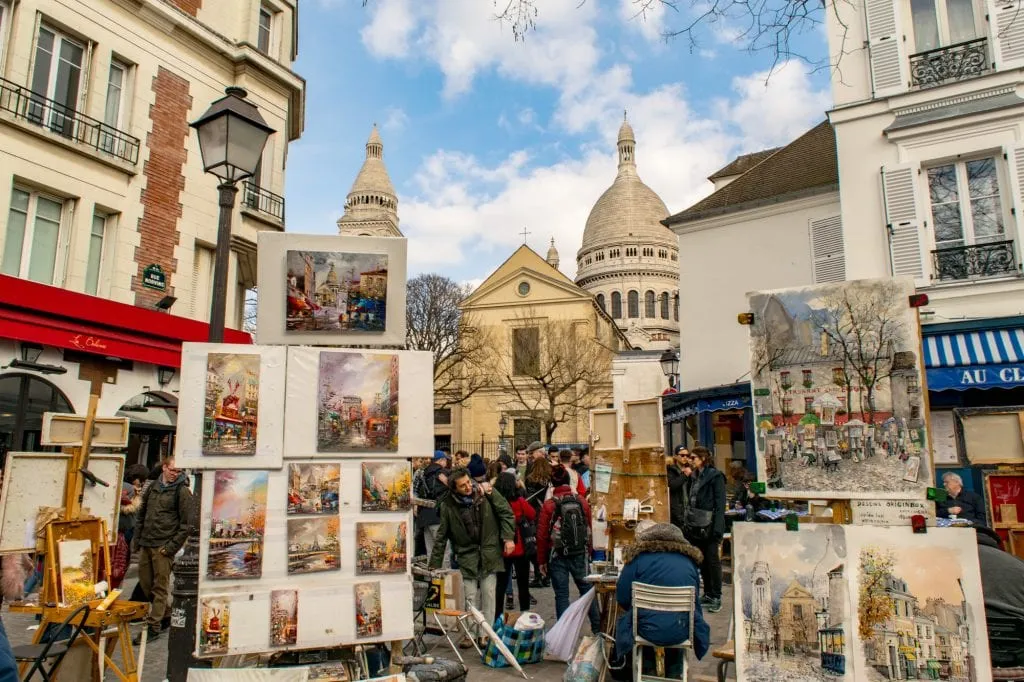
Watch the world go by at one of Montmartre’s many charming cafes or bistros.
Montmartre is positively covered in picturesque cafes and bistros, and sitting outside to enjoy a coffee and croissant in the mornings is a fabulous way to enjoy them.
Of course, given how popular visiting Montmartre is, many of the cafes and bistros have mediocre food, high prices, or both–but you can usually find somewhere worth enjoying.
The famous spots of Le Consulat (where you can drink at the same cafe Picasso and Monet once enjoyed, Le Refuge, and Le Vrai Paris all get solid, if not raving, reviews.
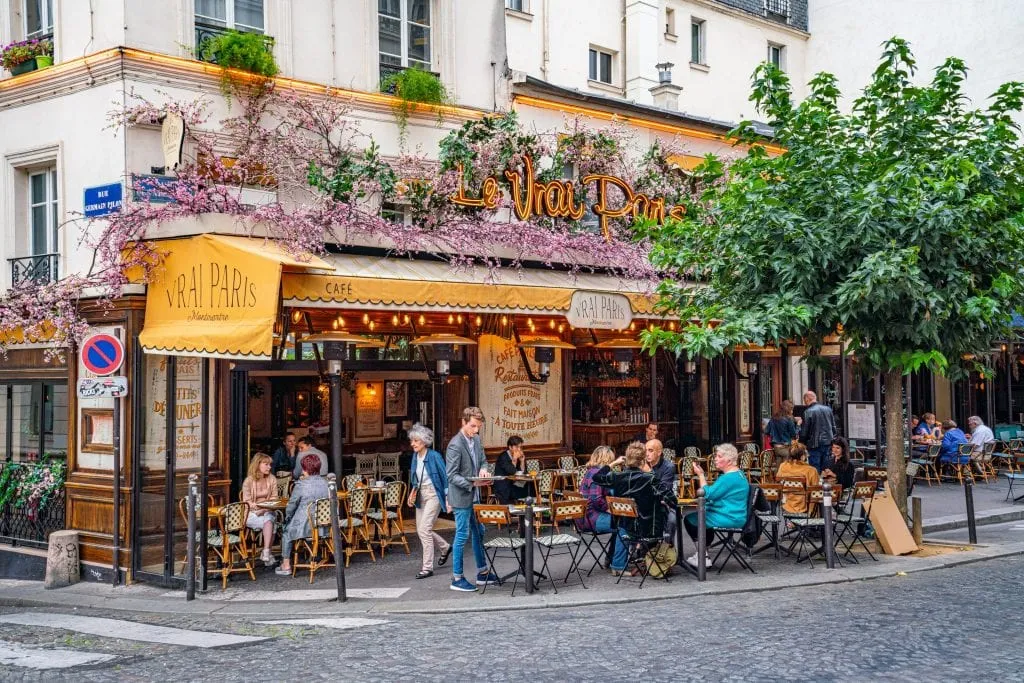
Café des Deux Moulins, which was featured in the movie Amélie, doesn’t get as good of reviews, but visitors hoping to enjoy the nostalgia seem to enjoy it.
We have also enjoyed a morning café at Le Bimbo, and Porto-Paris (Portuguese rather than French, but good).
And, while you can’t sit down there, I can’t talk about breakfast in Montmartre without mentioning Pain Pain, a former winner of the best baguette in Paris award and a must-taste when visiting Montmartre!

Stroll down the beautiful Rue de l’Abreuvoir.
Sandwiched between La Maison Rose at the top and Place Dalida at the bottom, the short street of Rue de l’Abreuvoir is one of the prettiest streets in Montmartre, and quite possibly one of the prettiest streets in all of Paris!
And, it’s without a doubt one of the 18th’s most famous photography spots.
As you walk down the street, be sure to turn back regularly to look behind you!
Like many of the most beautiful places in Montmartre, the domes of Sacré-Coeur will start peeking out over the top of the hill as you descend.
While not particularly busy, this is still an active driving street, so keep an eye out for cars as you explore!
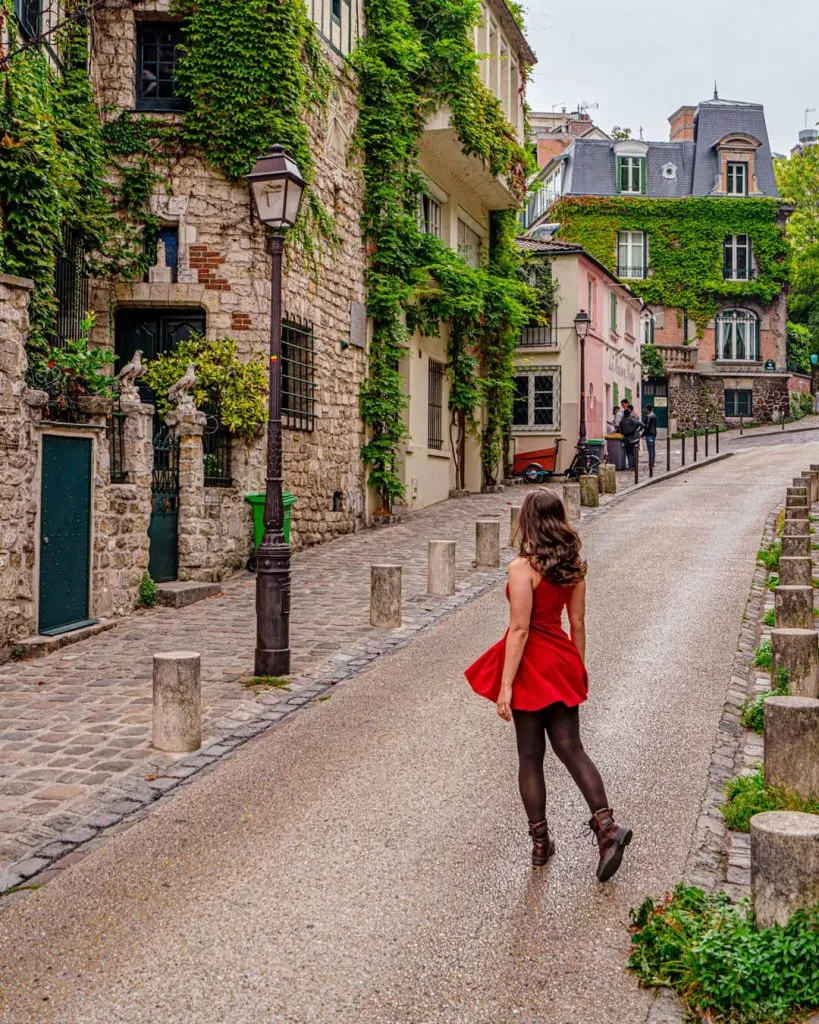
… and pause at the bottom to enjoy Place Dalida.
Shady and peaceful Place Dalida is situated at one end of Rue de l’Abreuvoir and features beautiful views of the picturesque street framed with the white domes of Sacré-Coeur.
It’s also home to a bust celebrating–who else–the famous French singer Dalida, who was known for performing in more than 10 languages.
Legend says that touching Dalida’s bust is good luck–and based on the discoloration, it’s easy to see that many people visiting Montmartre have given it a chance to work.
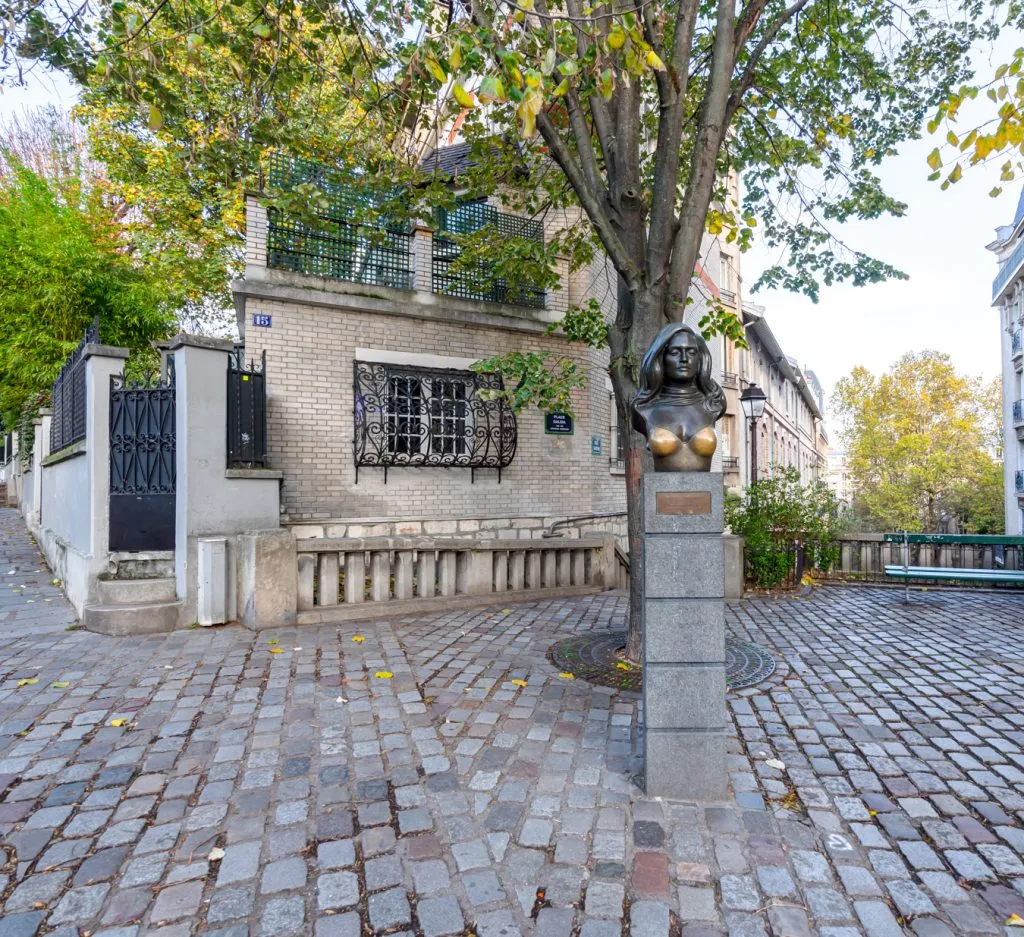
Explore the Montmartre Museum.
Generally speaking, Montmartre is less of a museum-hopping neighborhood and more of a place to soak up the atmosphere–but it’s worth making an exception for the Musée de Montmartre.
Housed in the former home of Auguste Renoir, the Montmartre Museum explores the history of the neighborhood.
Most of the attention is focused, of course, on Montmartre’s heyday starting in the 19th century, with exhibits on the building of Sacré-Coeur, the iconic shadow theatre of the original Chat Noir, a recreated apartment of Suzanne Valadon, and much more.
We thoroughly enjoyed the museum and the attached Renoir Gardens.
The gardens are also home to the best accessible view of Le Clos Montmartre, one of the only remaining vineyards in Paris!
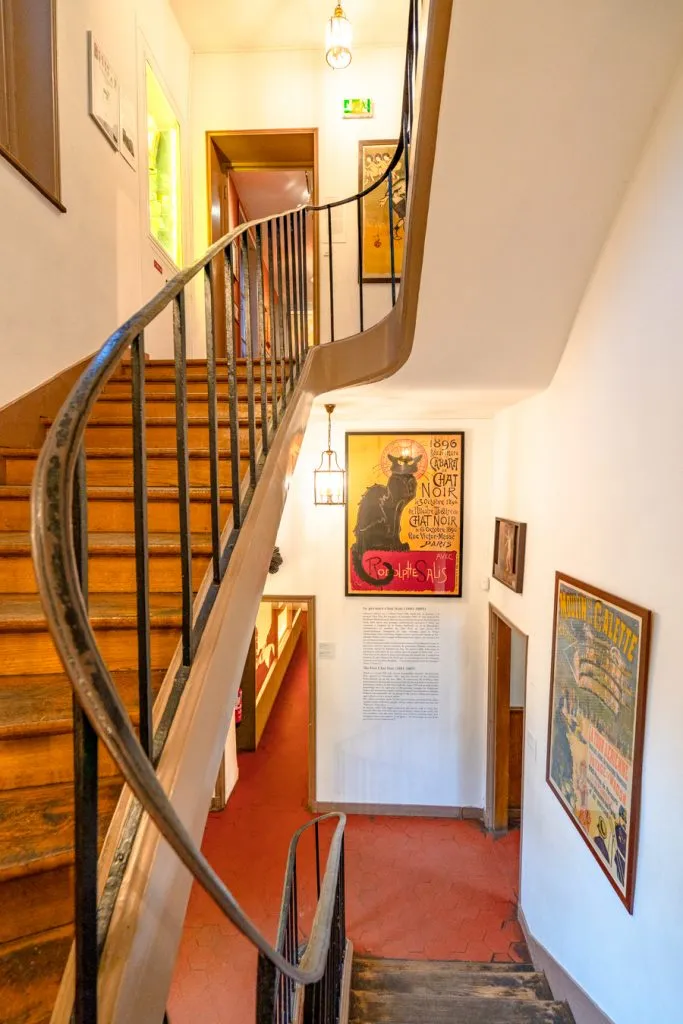
Admire the vines of Le Clos Montmartre (from outside the gate).
In a city as modern and busy as Paris, finding a small vineyard nestled amongst the buildings is an absolute treat!
And, what better home could there be for a quirky urban winery than Montmartre village, which already feels worlds apart from much of the city?
Unfortunately, Le Clos Montmartre isn’t generally open to the public, but that doesn’t stop travelers from eagerly peering through their front gate on Rue des Saules (it helps that the gate is just around the corner from La Maison Rose).
The best view of the vineyard, where I took the below photo, is from the Montmartre Museum’s gardens, but you’ll need to purchase a ticket to the gardens to access it.
Garden access is included with a museum ticket, or you can purchase only access to the gardens separately.
Le Clos Montmartre only produces a small amount of wine–1000 bottles a year or less–but if you’d like to try it, you can find it for sale around Montmartre (including in the Montmartre Museum gift shop).
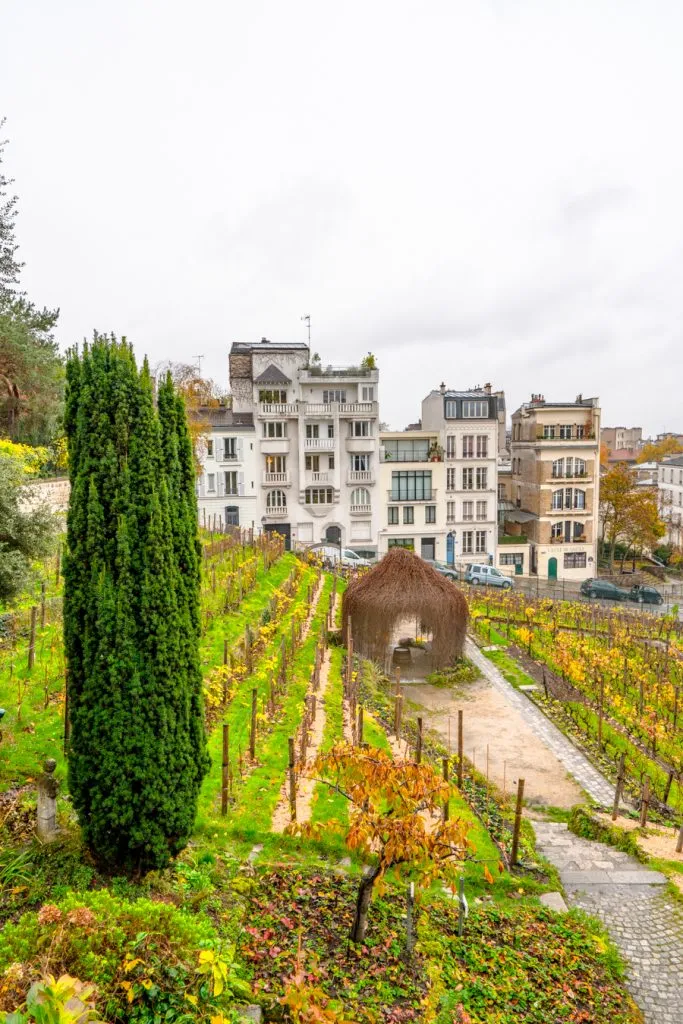
See the best of Montmartre’s cuisine on a food tour.
Want to sample delicious Parisian food while exploring Montmartre on foot with an excellent guide?
Consider booking a Montmartre food tour with Devour Tours!
Devour Tours is one of our favorite food tour companies in Europe (they’re also associated with Take Walks, another favorite of ours).
We loved this Paris food tour we booked with them, among several others!
Their Montmartre food tour offers an incredible combination of excellent food and memorable stories about the history and culture of the 18th arrondissement.
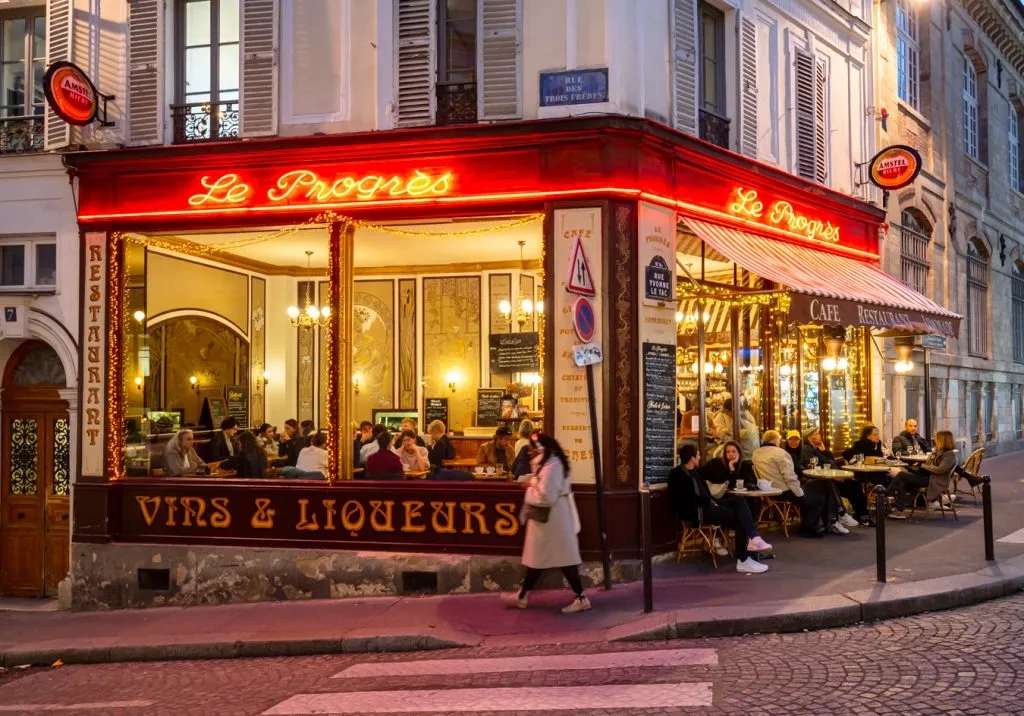
Visit the famous La Maison Rose.
Originally opened in 1908, the beautiful pink facade of La Maison Rose has been a staple of Montmartre for generations.
While it has gone through a handful of closures, reopens, and ownership changes over the years, its iconic pink facade dates all the way back to the original.
Staples of Montmartre, such as Albert Camus and Dalida, were once clients, and today, La Maison Rose remains a functioning restaurant (we highly recommend making reservations if you want to eat there).
Most visitors, though, no doubt come merely to admire the exterior.
The facade has been slightly updated in the few years since I took the below photo–“La Maison Rose” is now printed in a more modern, blocky green style.
I have to admit I’m still extremely partial to the script version, so opted to preserve my favorite version in this Montmartre blog post.
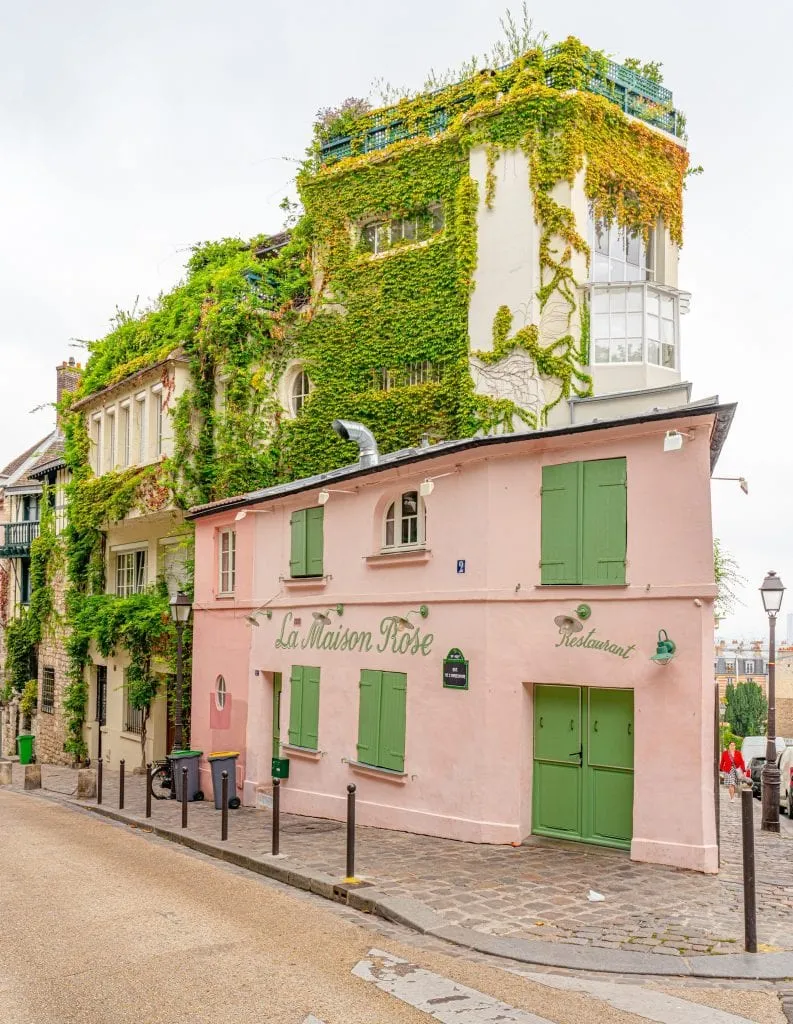
Enjoy the Place Saint-Pierre (and its carousel).
Tiny Place Saint-Pierre is one of the most recognizable places to visit in Montmartre, but you may have never heard its official name before–because Place Saint-Pierre is much better known for what sits inside it.
Home to the Montmartre carousel (technically named the Carrousel de Saint-Pierre, but generally referred to as the Montmartre carousel), the Place Saint-Pierre sits below Sacré-Coeur.
Rides are short but inexpensive, and popular with kids visiting Montmartre!
The carousel may be even more popular with photographers, though: the ability to capture the Sacré-Coeur and a historic Parisian carousel in one image is a delight.
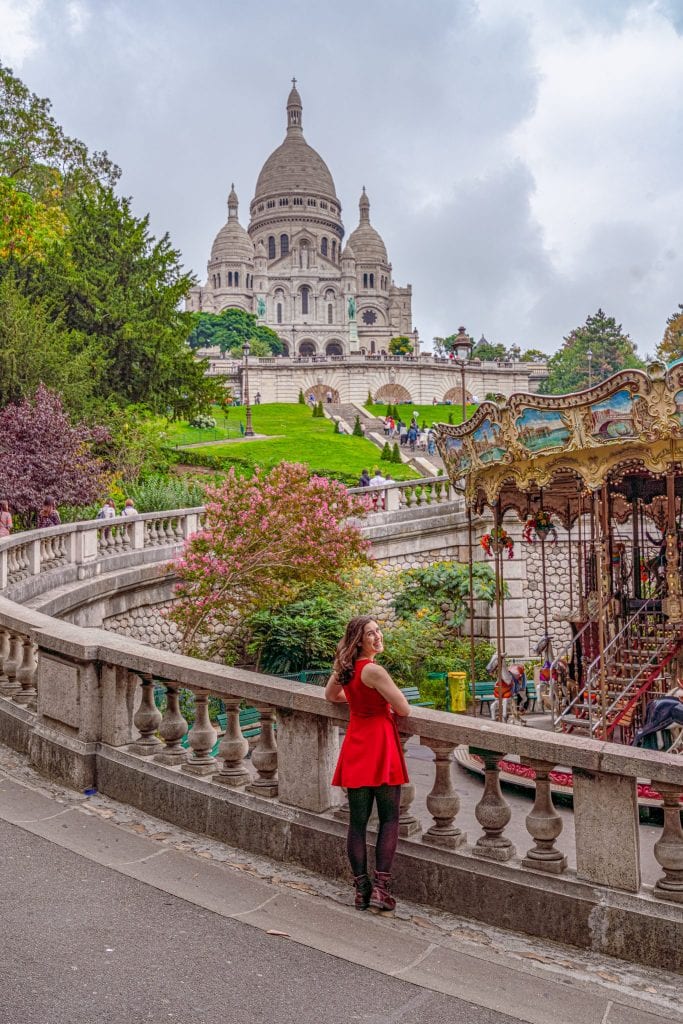
Find Montmartre’s remaining windmills.
Once upon a time, Montmartre was known for its many windmills.
Today, only a handful remain–including, Moulin Radet, the windmill that overlooks the restaurant La Moulin de la Galette.
There’s also a windmill named Moulin Blute-Fin, which is on private land but you can spot from the street.
Collectively, these two windmills are known as Moulin de la Galette, and they have been featured in paintings by Van Gogh, Renoir, and many more.
Meanwhile, the iconic windmill on top of the Moulin Rouge, while not technically in Montmarte, is near-synonymous with the neighborhood.
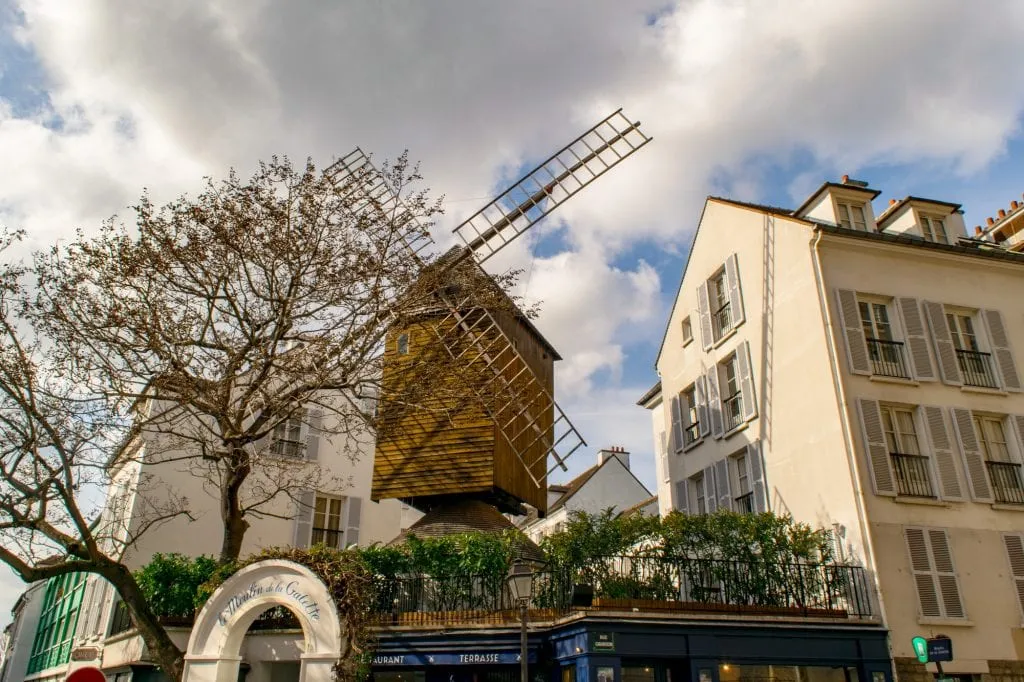
… and the quirky statue of Le Passe-Muraille.
The bronze statue of Le Passe-Muraille (or “Passer Through Walls”) is one of the quirkiest attractions in Montmartre, and only takes a minute to see!
Depicting a man stuck inside a wall as he attempts to walk through, Le Passe-Muraille is actually a statue of a specific character from the French novel Le Passe-Muraille.
The character, and therefore his statue, met his unfortunate fate of being permanently stuck in a wall after using magical powers for immoral purposes.
You don’t need to have read or even be familiar with the book, though, in order to appreciate this unusual art piece that feels right at home in the 18th arrondissement.
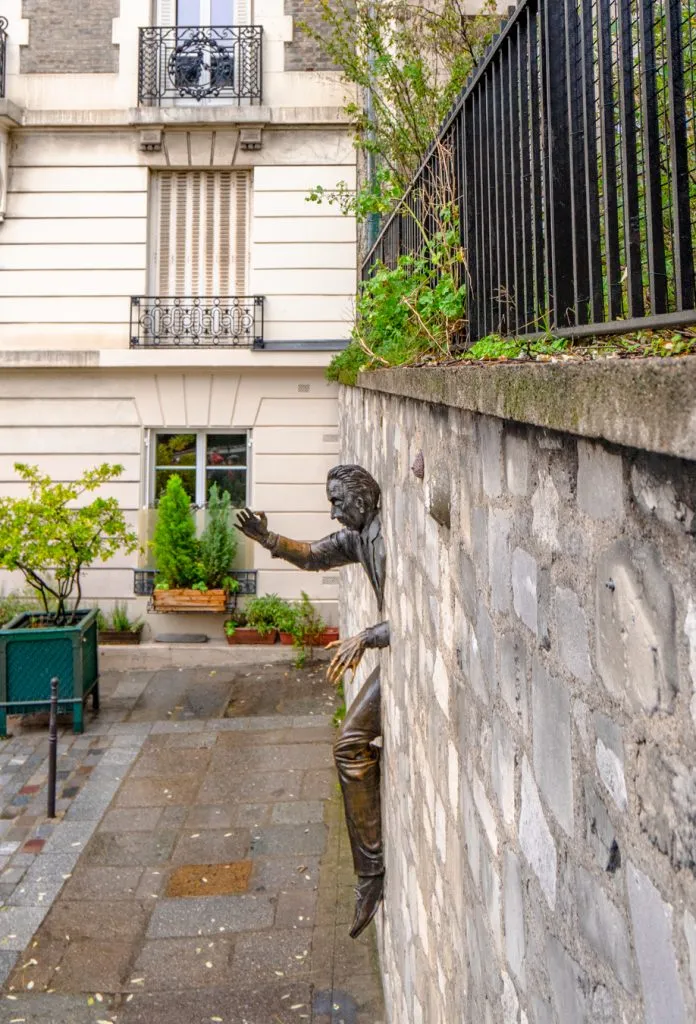
Spend some time relaxing on the Sacré-Coeur steps that overlook Louise Michel Park.
Enjoying the view of Paris from the steps leading to the Sacré-Coeur is one of the most popular things to do in Montmartre, especially at sunset!
Regardless of what time you visit, though, it’s worth stopping to rest and enjoy the view (especially if you just climbed the roughly 270 steps it takes to reach the Sacré-Coeur from Place-Saint Pierre).
However, be cautious: the combination of the viewpoint being popular and free to access means that pickpockets and scammers are rife here.
That’s not a reason to stay away, but it’s definitely a reason to be extra cautious with your belongings.
We have enjoyed several stunning Paris sunsets from this spot, and hope to see many more in the future!
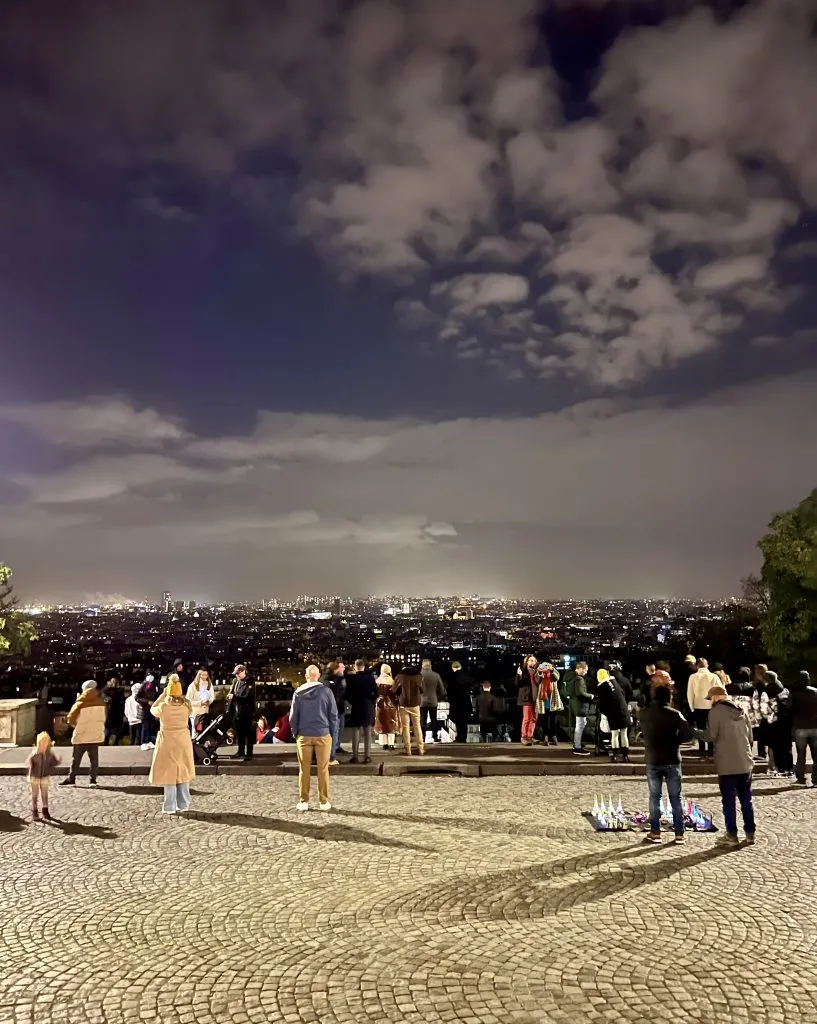
… and don’t miss seeing the Sinking House of Montmartre while you’re there!
The Sinking House of Montmartre is one of Paris’ most beloved optical illusions, and it’s very easy to find during a Montmartre visit!
If you’re standing amongst the crowd on the steps of the Sacré-Coeur, face the basilica and then turn to your right.
You’ll see a red building jutting out in the distance, beyond the lawn.
Turn your camera (this is our beloved camera, though we shot the below photo years ago on this one) so that the lawn is straight.
Voilà–suddenly the red building is “sinking”!
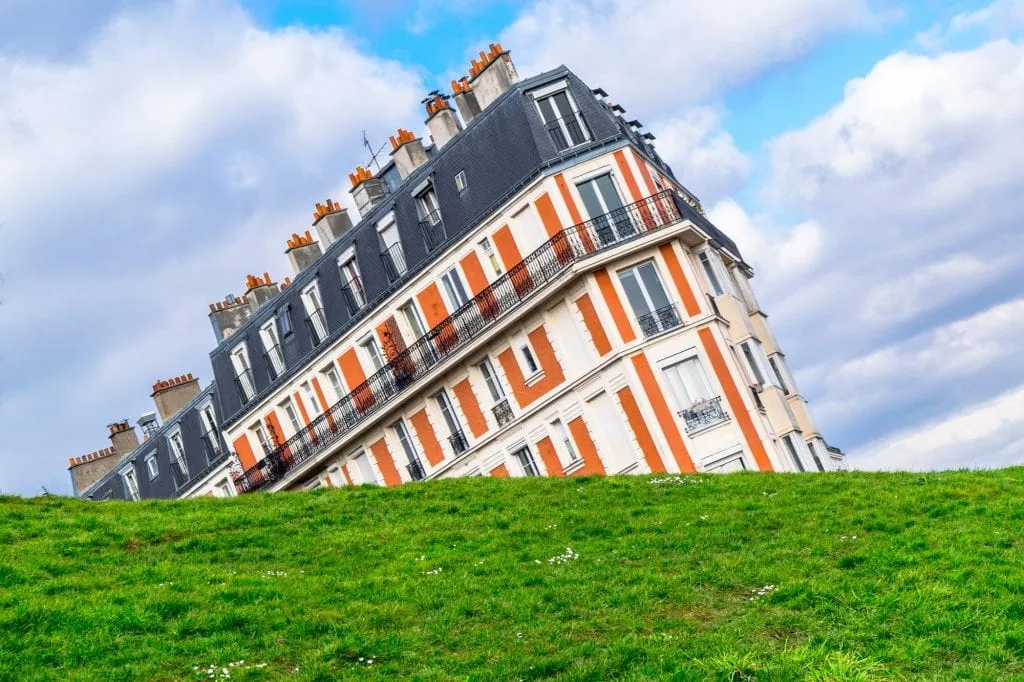
Seek out “secret” Eiffel Tower views from Montmartre.
Meander along the top of the Montmartre butte long enough, and you’ll come across some pretty spectacular views of Paris that you won’t find on any map or in any guidebook.
Often visible in only a small sliver when peering through buildings or trees, these views are all the more rewarding for how surprising it often feels to stumble across one (and many of them even overlook the Eiffel Tower).
Here’s one spot to get you started: navigate to the restaurant Chez Plumeau, located just around the corner from the Place du Tertre.
Start at the top of the staircase, and then meander along the edge of the wall, and you’ll find plenty of gorgeous Eiffel Tower views!
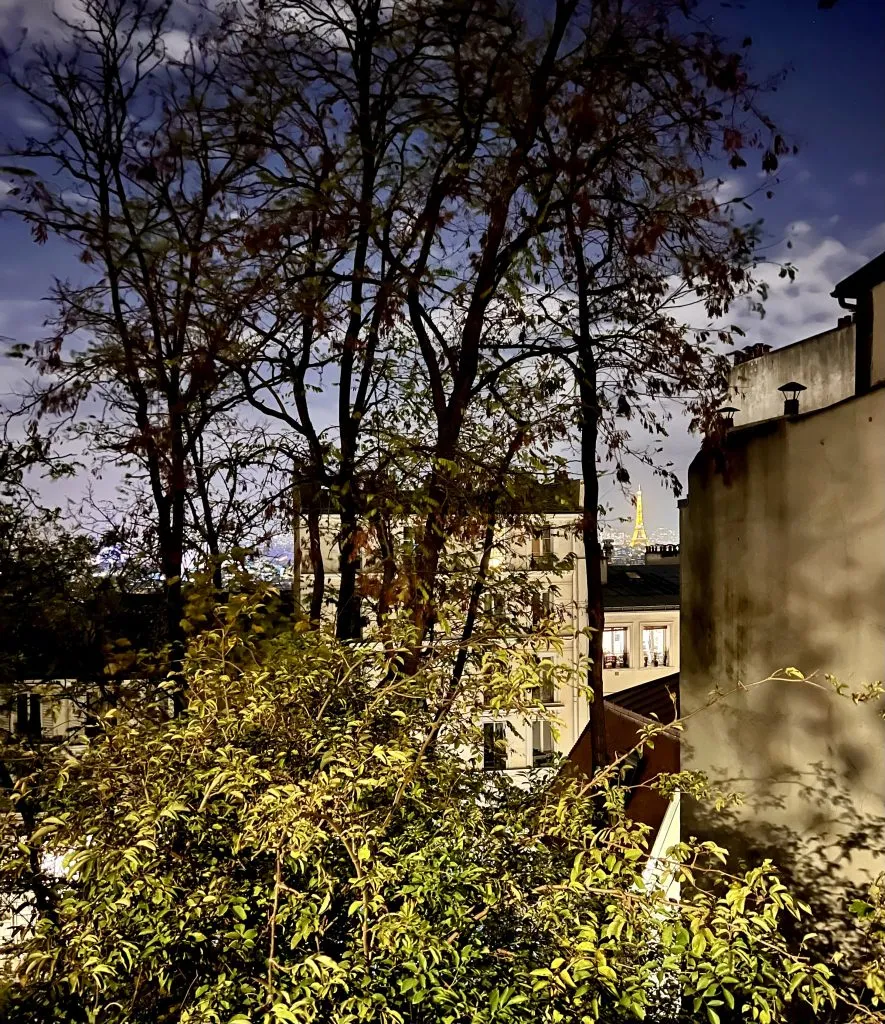
Duck inside the second-oldest church in Paris.
Situated right between Sacré-Coeur and Place du Tertre, you might suspect that the second-oldest church in Paris would be crowded with visitors–but this is actually one of the many hidden gems of Montmartre that are tucked away in plain sight.
Construction of the Church of St. Pierre de Montmartre began in 1133, though it is believed that a church has stood on this site since the 3rd century.
Home to the Montmartre Abbey before the French Revolution, St. Pierre de Montmartre has a long history in the 18th arrondissement–significantly longer than the more-famous Sacré-Coeur.
The interior is fairly simple, with featured stained glass and lots of stone, but lovely and worth a quick peek inside (it’s free to visit).
St. Pierre de Montmartre is also home to the Calvaire Cemetery, which you should definitely visit if you get the rare opportunity.
It’s only open one day a year, on All Saint’s Day (November 1)!
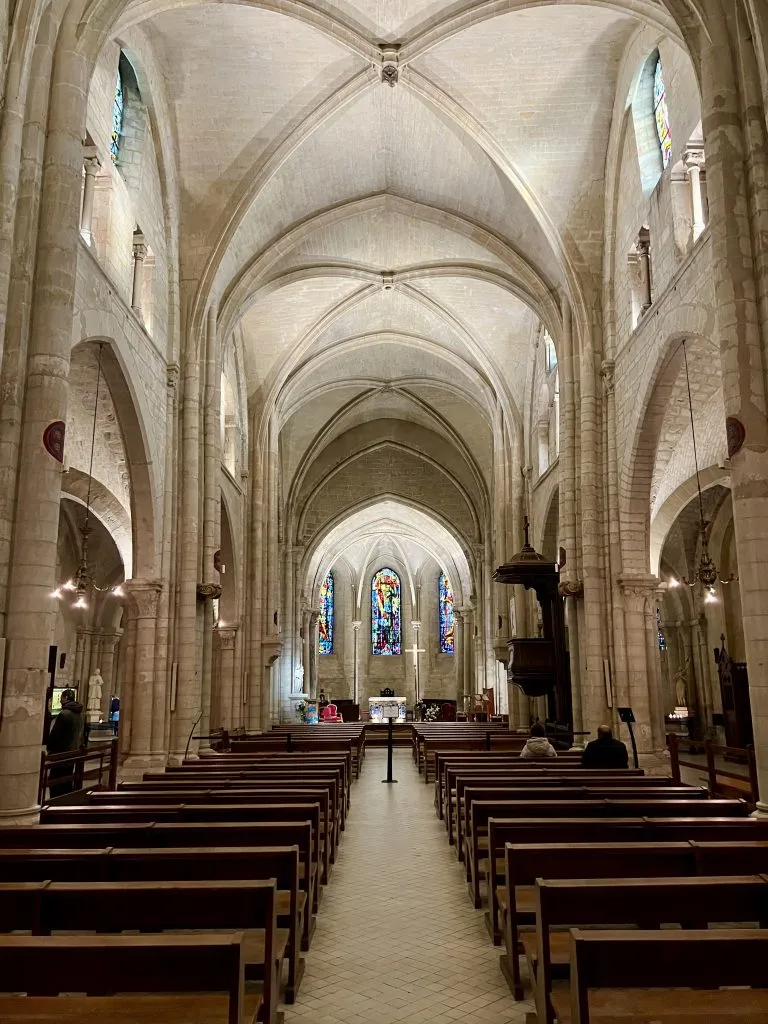
Enjoy a world-famous cabaret beloved by Picasso at Cabaret Au Lapin Agile.
Dating to 1860 and the inspiration behind a Picasso painting of the same, Cabaret Au Lapin Agile bills itself as Paris’ oldest cabaret.
Situated in the heart of Montmartre (along Rue des Saules), and once the haunt of many of Montmartre’s most famous residents, the party is still going like it’s the Belle Époque every night in Au Lapin Agile.
Today’s version is touristy, yes–but still lots of fun.
Be sure to make reservations in advance if you want to spend an evening in Montmartre tucked inside this lively spot.
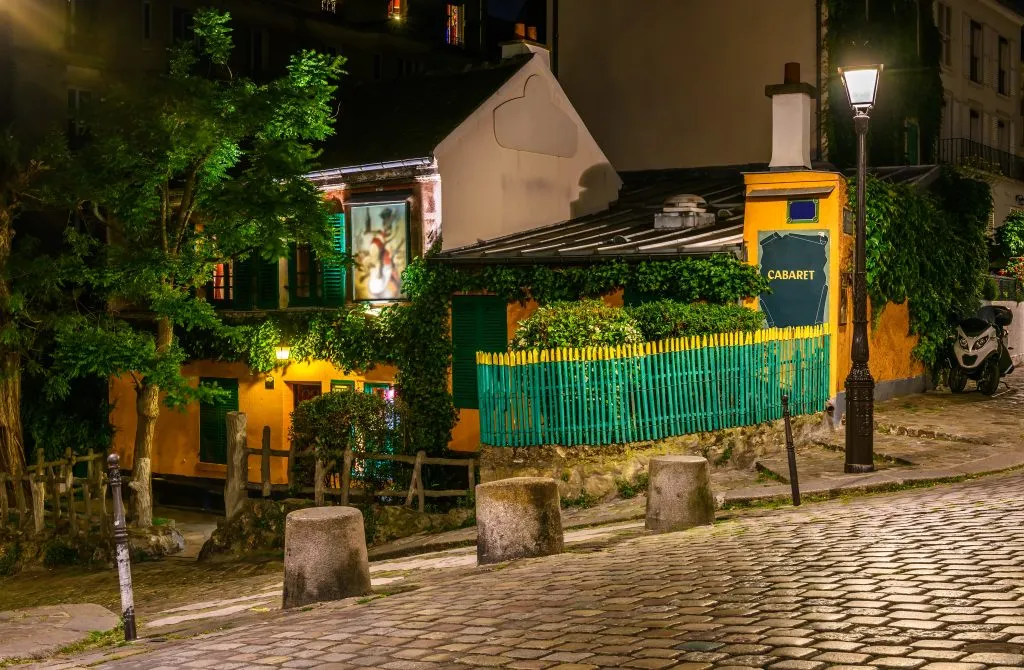
Snap a selfie with someone you love at the “I love you” wall.
Located in Square Jehan-Rictus, just a few steps from the Abbesses metro stop, you’ll find one of the most beloved Montmartre photo spots!
The dark blue Wall of Love is adorned with the phrase “I love you” in more than 300 languages, making it the perfect place to visit with one of your favorite people.

Stroll along some of Montmartre’s most picturesque streets.
Montmartre is made for wandering, and one of the absolute best things to do in Montmartre is to turn down random streets and find your favorites.
A few of the prettiest streets in Montmartre include the famous Rue de l’Abreuvoir, the winding Rue Lepic, and Rue Abbesses.
Rue des Saules is well worth a stroll as well, as are Rue Andre Antoine and Rue Lamarck.
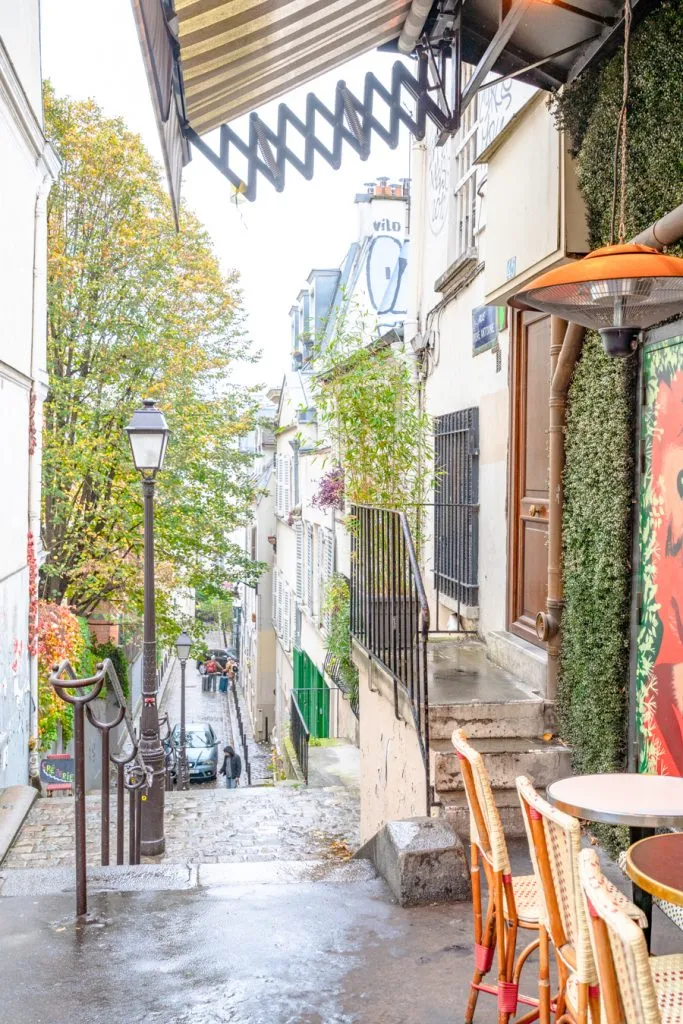
Pay a visit to the Montmartre Cemetery.
As the largest cemetery in Montmartre and the third-largest cemetery in Paris, the Montmartre Cemetery (technically named Cimetière du Nord) is the final resting place of many of the 18th arrondissement’s most famous residents!
Located in a former quarry, strolling through the Montmartre Cemetery definitely gives the impression that you’re wandering beneath the ground (though it is all open air–just sunken).
Alexandre Dumas, Dalida herself, and many more were laid to rest here.
The Montmartre Cemetery is free to visit and an easy addition to most Montmartre itineraries.
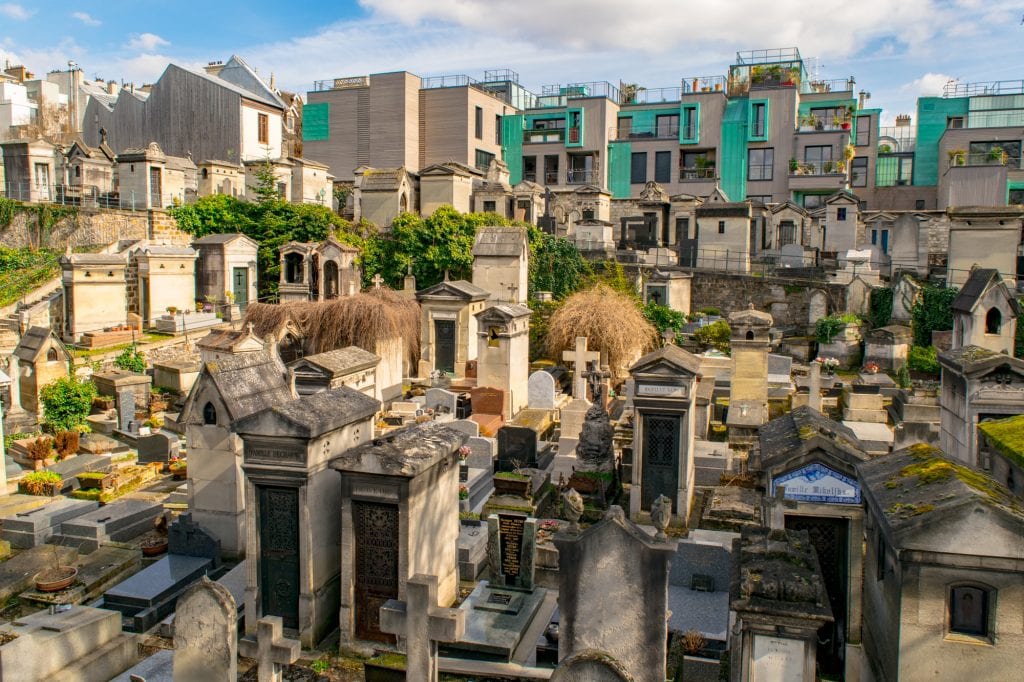
Seek out Amélie filming locations.
The popular French movie Amélie just may be the most beloved piece of cinema that has ever been filmed in Montmartre!
As a result, visiting Amélie filming locations is popular in Montmartre (and if you don’t know what I’m talking about, watching the movie before visiting will definitely inspire you to visit Montmartre)!
Café des Deux Moulins and Au Marché de la Butte (which played the Maison Collignon grocery store) are 2 of the most popular spots to visit that won’t necessarily already be on your Montmartre bucket list.
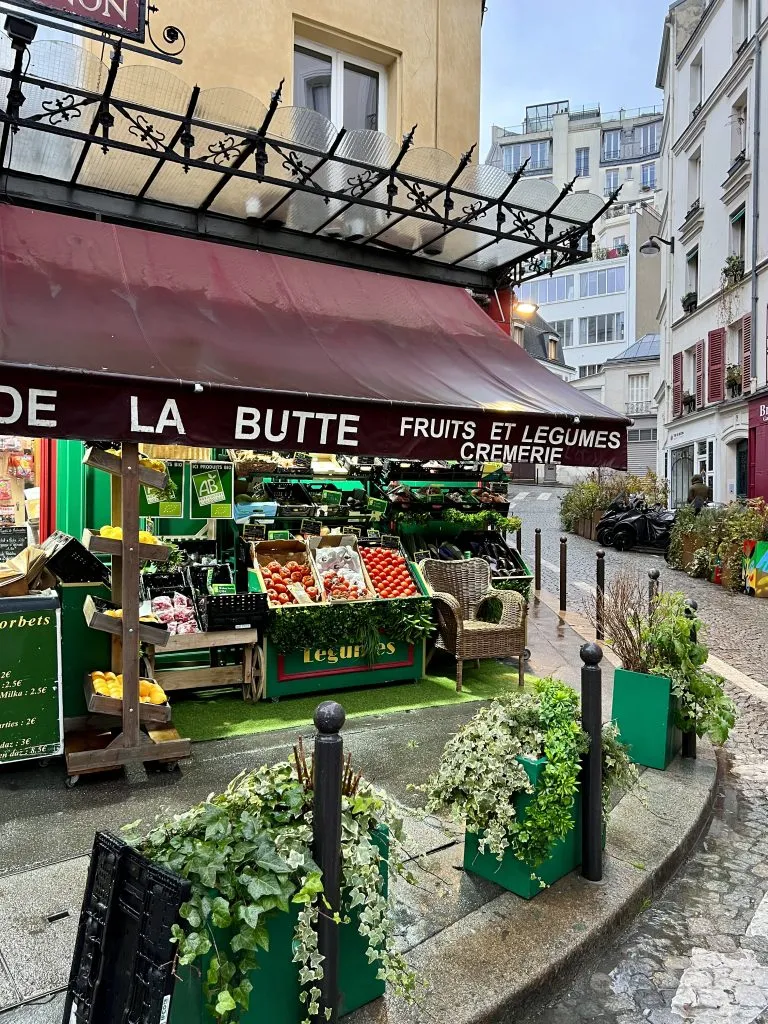
Wander through the St. Vincent Cemetery.
The final resting place of many of Montmartre’s former poets, artists, actors, and more, the peaceful St. Vincent Cemetery is a smaller and quieter alternative to visiting the larger Montmartre Cemetery.
Free to visit and home to notable Parisians like Maurice Utrillo, Léontine Aubart, and more, the cemetery also has a view of the rooftop of the famous Au Lapin Agile Cabaret.
There are also free public toilets located inside the cemetery, a nice perk for travelers who have been pounding the pavement on a self-guided Montmartre walking tour.
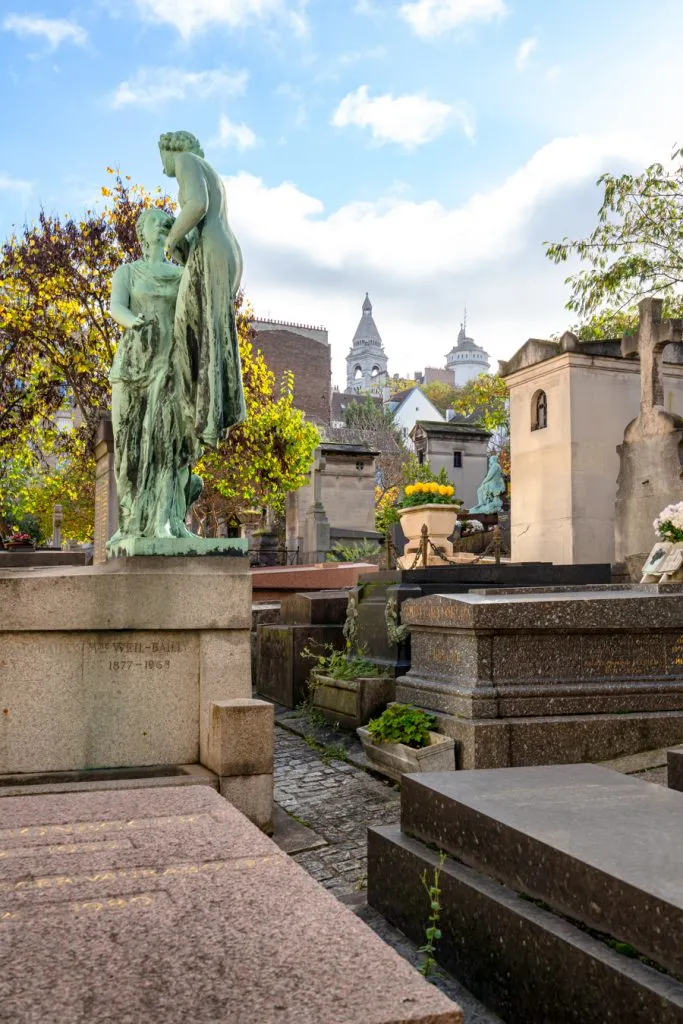
Explore the Espace Dalí Museum.
Dedicated to the one and only Salvador Dalí, the Dalí Museum features over 300 works by the prolific artist.
Originally amassed as a private collection, Espace Dalí was completely redone in 2018.
If your taste in art leans more toward the contemporary, this is the place in Montmartre for you!
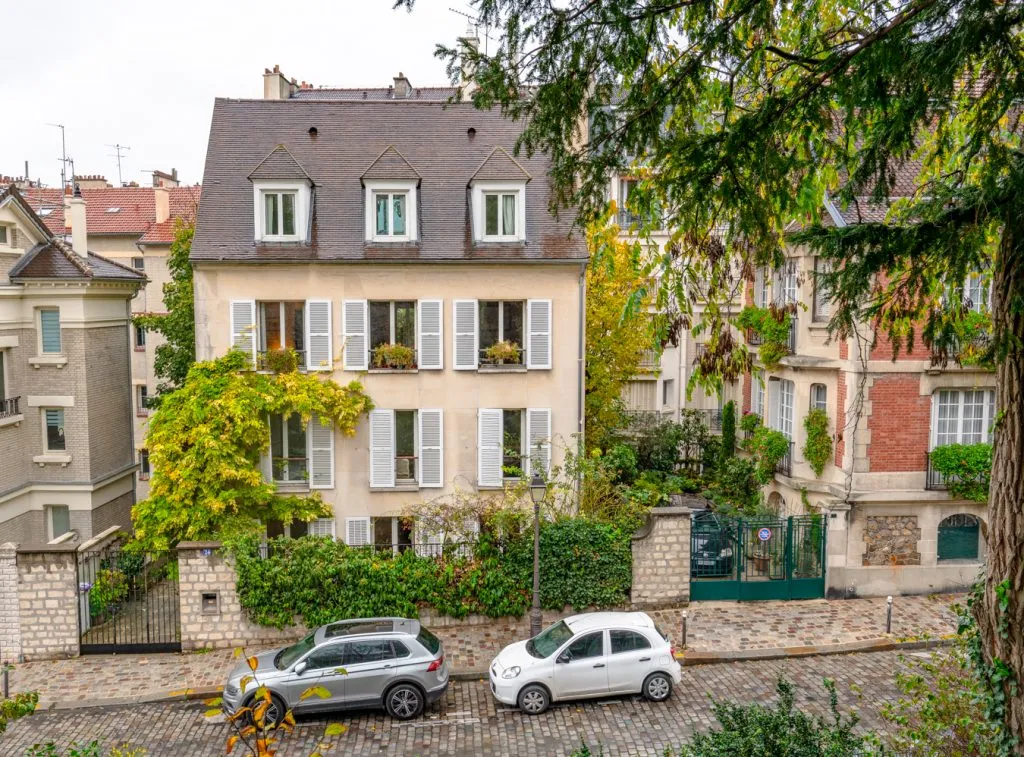
Wander aimlessly and find your own unusual places to visit in Montmartre.
Cliche it may be, but to this day, one of the most rewarding things to do in Montmartre is simply to wander through the neighborhood!
From quiet cafes to stately homes to shady staircases to quirky shops to unusual views of Paris (including the Eiffel Tower), Montmartre’s a wonderful place to explore on foot.
On our most recent trip to Montmartre in Paris, we stumbled across a Portuguese-themed coffee shop among many other treasures, which delighted us to no end as we had a chance to reflect on the 14 months we lived in Lisbon.
We wouldn’t have found that shop in a guidebook, but it was a memorable stop all the same.
Just remember to wear comfortable shoes and prepare for hills when exploring on foot: visiting Montmartre involves climbing lots of hills!
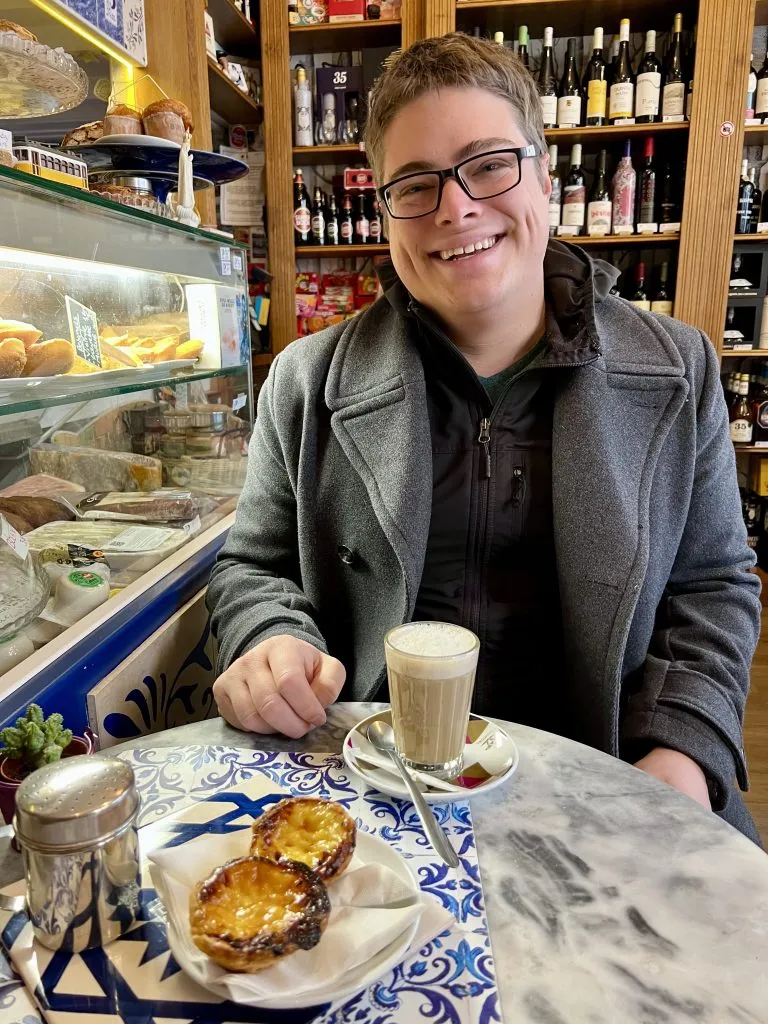
Fun Things to Do Near Montmartre
Just outside the boundaries of the neighborhood, you’ll find several more fun things to do near Montmartre.
That includes one of Paris’ most famous attractions, too–one that is often associated with the 18th arrondissement…
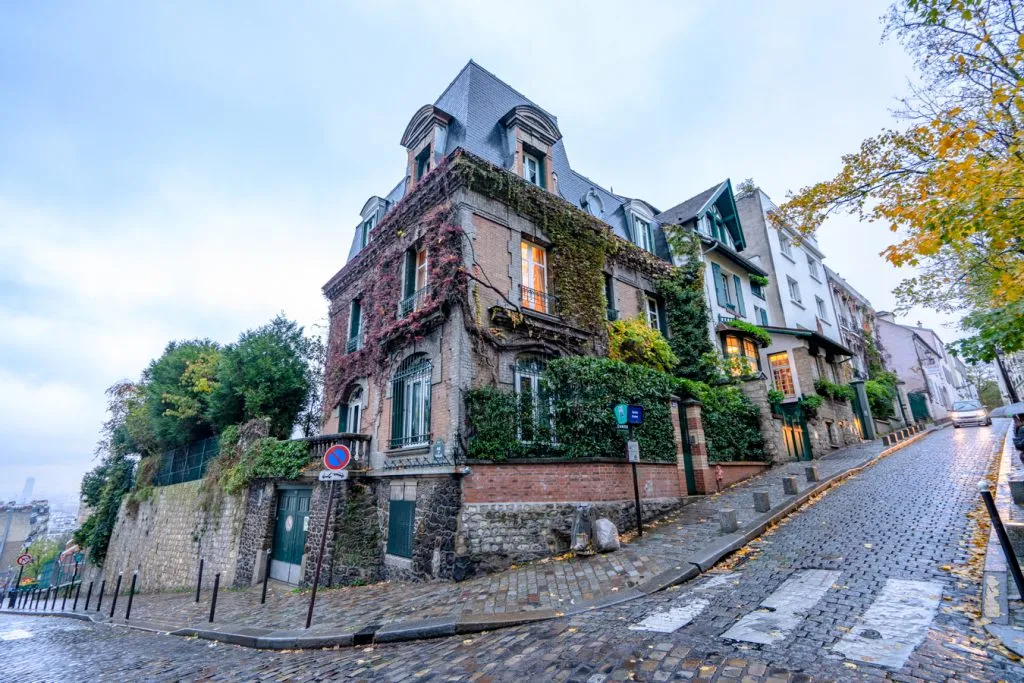
See a show at the famous Moulin Rouge!
Thanks in large part to the 2001 movie starring Nicole Kidman and Ewan McGregor, the Moulin Rouge is one of the most recognizable Montmartre landmarks.
… but it’s not technically located in Montmartre!
Located in the Pigalle district just south (and downhill) from Montmartre, the Moulin Rouge is Paris’ most famous cabaret and is topped by its most recognizable windmill.
You can file this one under “indisputably touristy and extremely memorable”, and most people love the performance (think variety show, not cohesive play).
If you want to see the cabaret show, be sure to book at least a couple of weeks in advance!
Even if you don’t go inside, though, it’s worth stopping by for a quick photo op with the windmill.
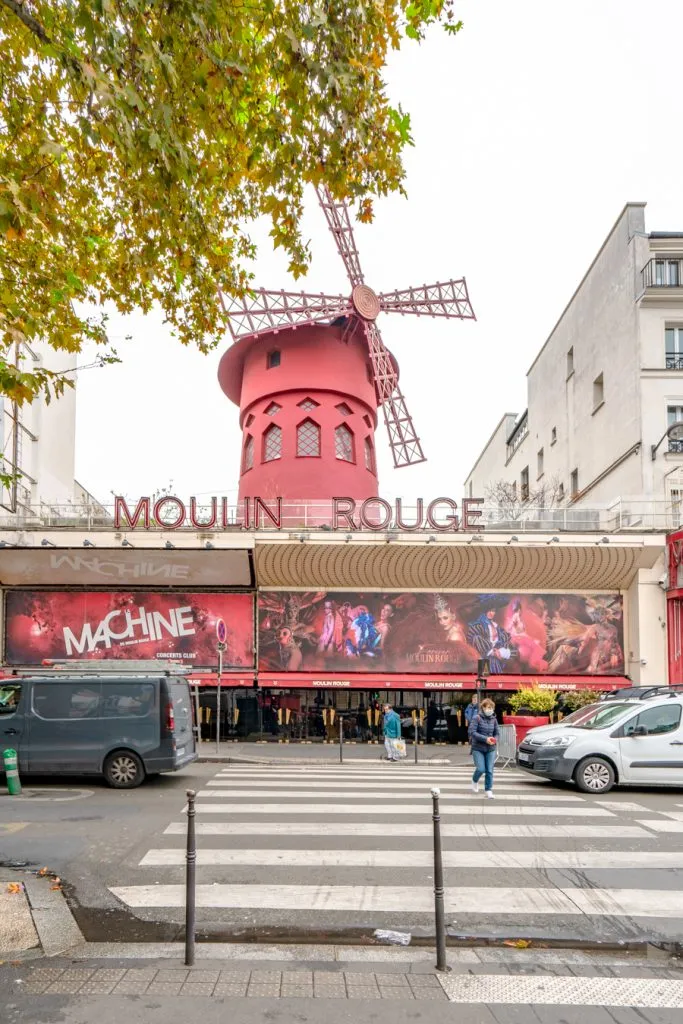
… and pay a visit to the current Le Chat Noir.
Thought to be the original Parisian cabaret, a form of nightlife that took Montmartre by storm at the end of the 19th century, Le Chat Noir has an enduring legacy in the area.
If you visited the Montmartre Museum, you no doubt learned all about the original Le Chat Noir and its unique “shadow play” that helped make it an icon.
And, if you’ve ever so much as glanced into a shop when browsing for Paris souvenirs, you have no doubt seen posters, placemats, and more decorated with the black cat drawings that have their origins at Le Chat Noir (translation: the black cat).
While the original Le Chat Noir has been closed for over a century, a later location opened in 1907 is still in business to this day.
Reviews are solid if not exceptional, and the atmosphere is a clear nod to Montmartre’s historic cabarets, complete with live music every night.
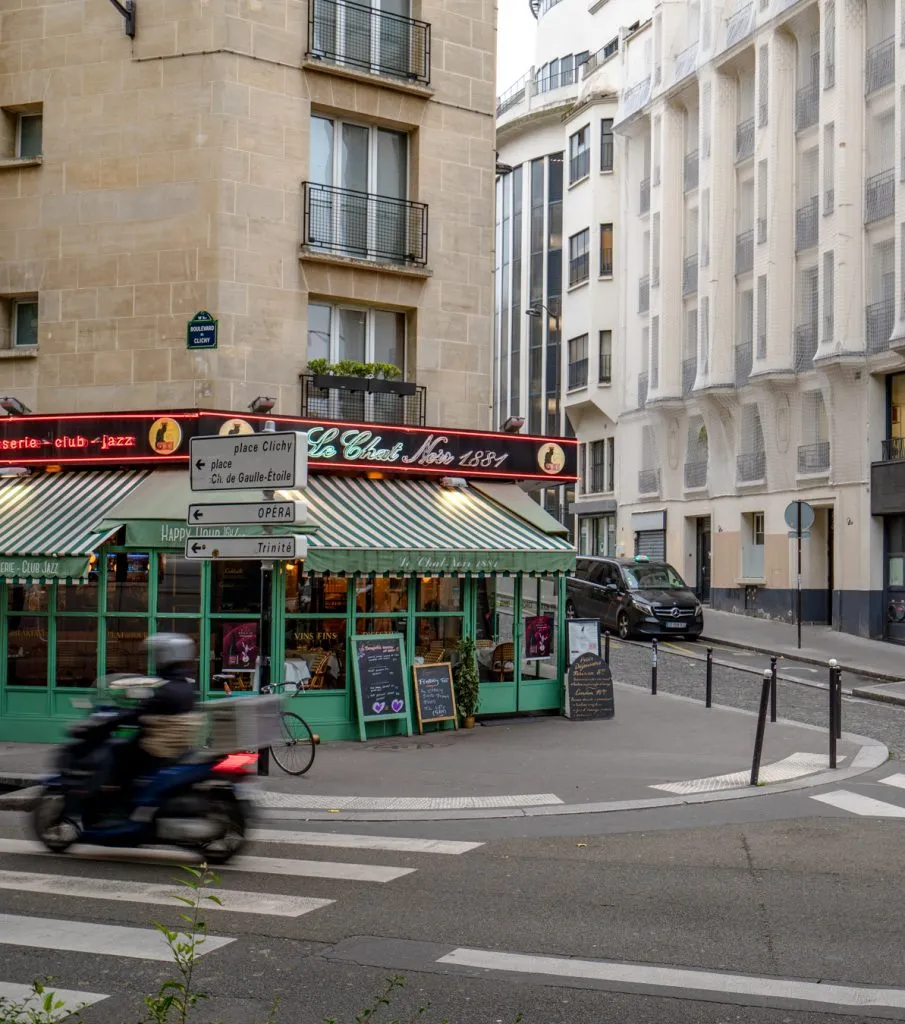
Check out the Museum of Romantic Life.
Housed in a pretty and delicate home dating to 1830, the Musée de la Vie Romantique explores a literary side of Paris, with a focus on George Sand.
Peaceful and quiet, the Museum of Romantic Life is tucked away in a charming courtyard that feels worlds away from central Paris (though if you visit during recess, you’ll hear the nearby schoolchildren playing!).
The museum includes a garden which is home to a pretty cafe, perfect for relaxing a bit before continuing your sightseeing in Paris.
The permanent exhibitions are free to visit, and we felt like we had the museum all to ourselves when we visited a few years ago.
However, now that the Museum of Romantic Life was briefly featured in season 3 of Emily in Paris, it may get a bit more crowded!
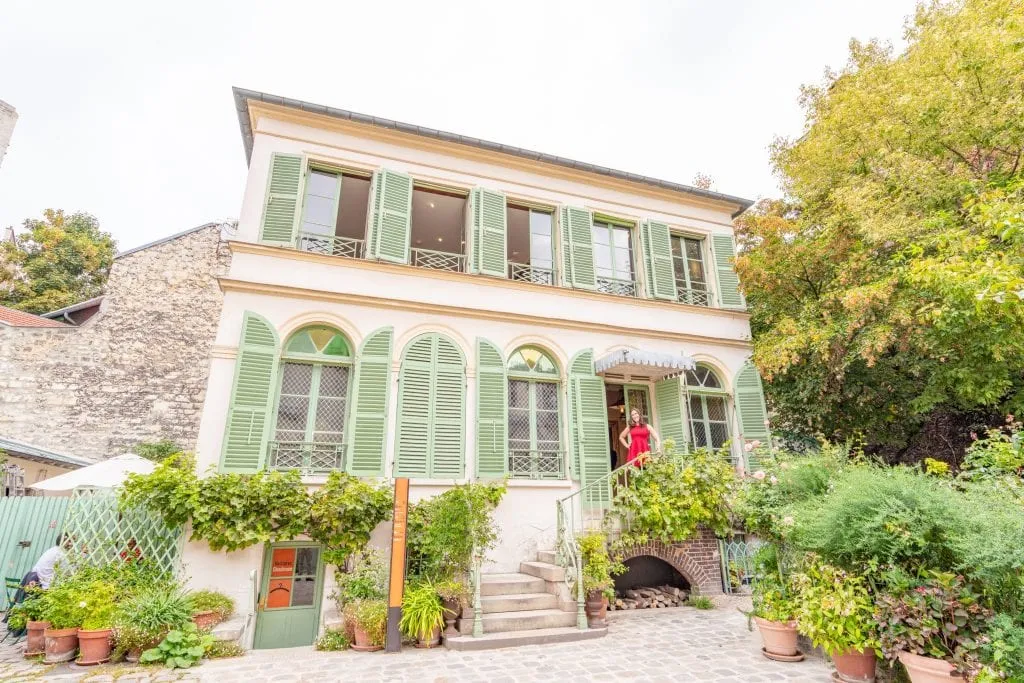
Where to Stay in Montmartre
Hoping to make Montmartre your base for your trip to Paris?
As much as we love Montmartre, we first need to caution that given Montmartre’s comparative remoteness to many of the other things to do in Paris, it may not be the best fit–and we say that as travelers who have stayed in Montmartre twice and loved it both times (this is where we stayed most recently).
Generally speaking, we would suggest that most first-time visitors to Paris choose a more centrally located neighborhood to stay in (the Latin Quarter (5e) or Saint-Germain-des-Prés (6e) fairly close to the Seine are our go-to suggestions).
However, if you’re a repeat visitor to Paris who loves Montmartre, or you’re hoping to save money by staying a bit further out, Montmartre can be a lovely option as long as you’re prepared to “commute” to most of the top things to do in Paris.
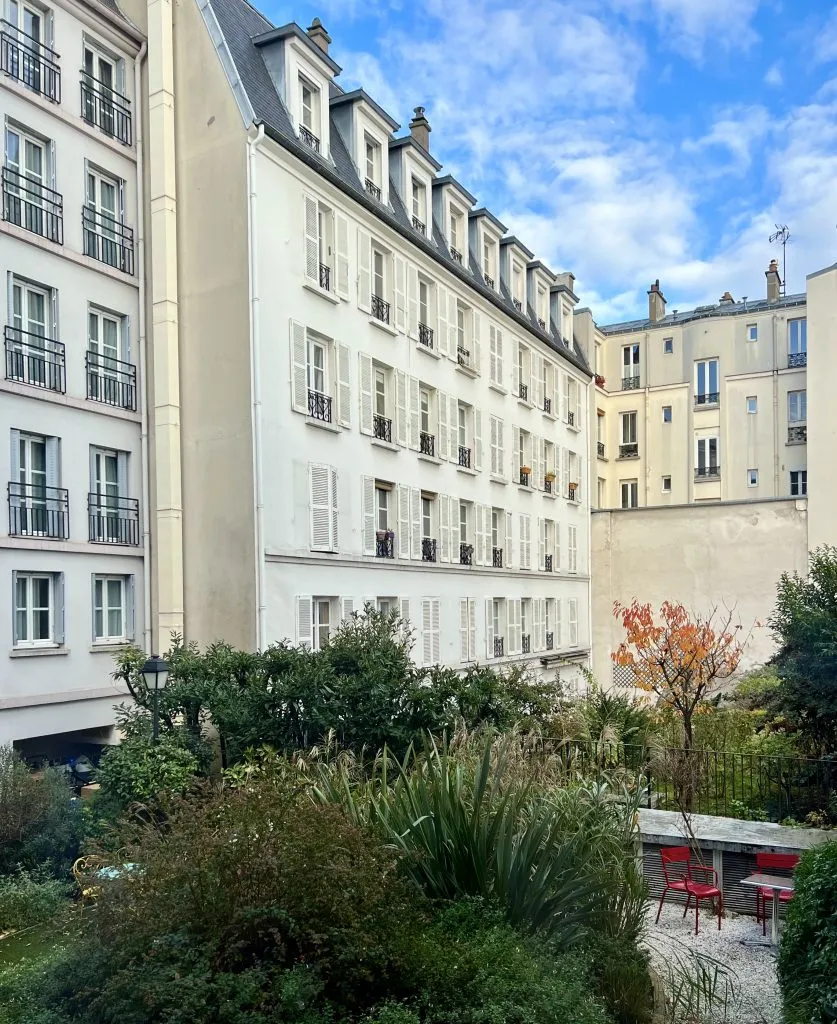
During our first trip based in Montmartre, we checked into Hotel Bellevue Montmartre (small rooms but adequate), and most recently at the Aparthotel Adagio Paris Montmartre, which we loved!
As you leave the boundaries of Montmartre itself, the nearby Pigalle area (where the Moulin Rouge is) can be a bit louder due to the nightlife, as well as a bit less refined, so keep that in mind as you’re browsing places to stay in Montmartre.
Ateliers de Montmartre ADM and the Mom’Art Hotel are two well-reviewed properties we’d love to stay in during future trips to Montmartre.
Check rates & book your stay in Montmartre today!
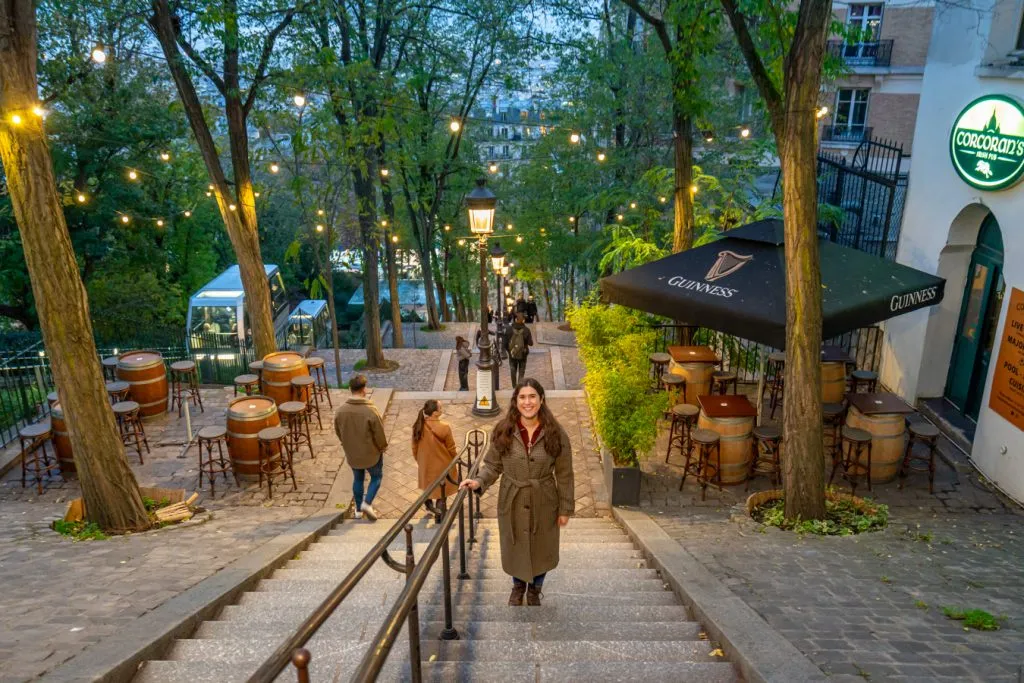
Where is Montmartre in Paris? (+ How to Get There)
Paris is famously divided into 20 arrondissements, or neighborhoods, that are named via a number system that starts with 1 in the center of the city and circles outward like the shell of a snail.
Montmartre is the 18th arrondissement and is located on the outskirts of the city center, just north of Pigalle (where the Moulin Rouge is).
Because it is fairly far removed from–not to mention uphill from–many of the other popular things to see in Paris (it would take roughly an hour and 15 minutes to walk to Sacré-Coeur from the Eiffel Tower, for example), most visitors don’t arrive in Montmartre on foot.
You can either head to the Abbesses stop (Line 12), the deepest metro in Paris, and right next to the Wall of Love, or go to the Anvers stop (Line 2) and walk directly up Rue de Steinkerque from there until you dead-end into the Sacré-Coeur.
If you head to Abbesses, be sure to take the elevator/lift out of the station–it takes 144 steps to reach the surface!
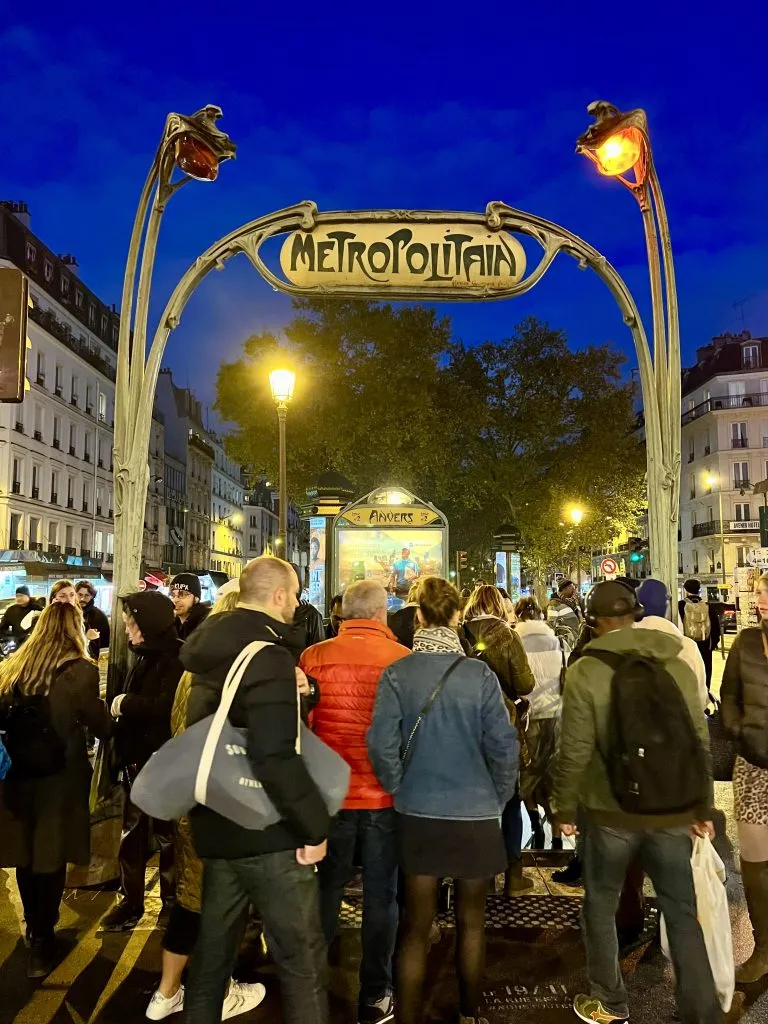
The Lamarck–Caulaincourt (Line 12) is another option on the north side of Montmartre, near Le Refuge. Its photogenic entrance is worth a look!
If you’d rather not take the metro, a taxi or Uber is always an option as well.
If you’d like to walk at least one leg of the trip to and from Montmartre, we recommend walking as you leave (downhill).
The Palais Garnier and Galeries Lafayette flagship store (with its famous dome and rooftop view) are about a 30-minute walk downhill from Montmartre.
The journey is part of the fun on this route, though: take the Rue des Martyrs and you’ll be surrounded by distractingly tempting cafes, bakeries, cheese shops, butcher shops, fruit stands, and more as you meander back toward more central neighborhoods in Paris.
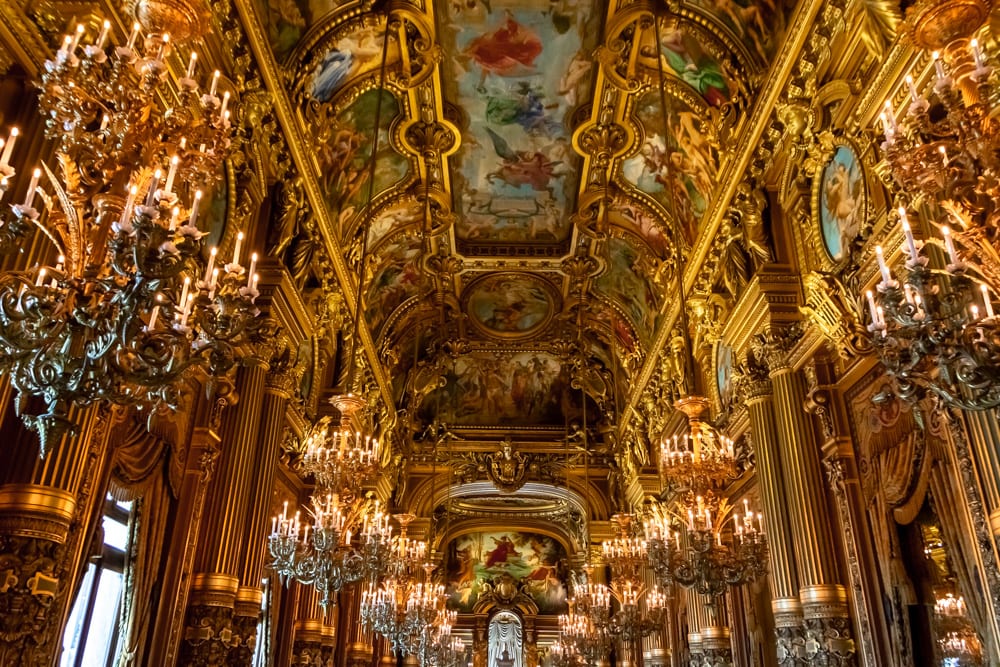
Tips for Visiting Paris’ Montmartre Neighborhood
Be prepared to climb lots of hills!
There’s no getting around it: exploring the best things to do in Montmartre means climbing lots of hills, including several steep staircases!
This can be somewhat mitigated in a few places, but ultimately, it’s an unavoidable feature of the neighborhood.
To limit your climbing, you can take the Montmartre Funicular from near the Place St. Pierre to the base of Sacré-Coeur for the price of one metro ticket.
The Montmartre tourist train is also a cute way to stay off your feet, especially if you’re visiting Montmartre with kids.
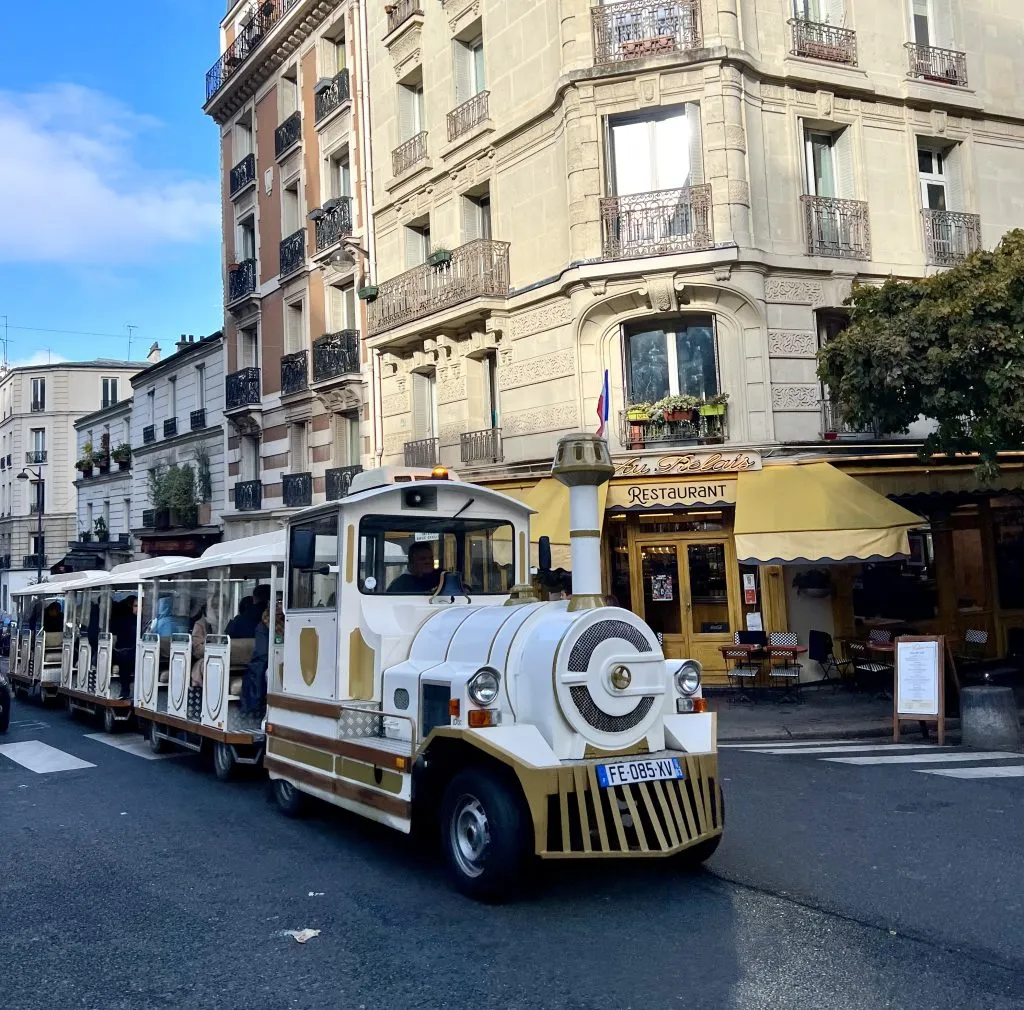
Keep an eye out for scams, especially on the steps of Sacré-Coeur.
Petty tourist scams are, unfortunately, a persistent issue in parts of Montmartre.
In particular, be cautious near the Place du Tertre, Place St. Pierre (near the carousel Sacré-Coeur), and especially on the Sacré-Coeur steps.
Common scams include unlicensed roving artists charging too much for mediocre (or worse) work, “friendship bracelets” offered for free and then charged for once they’re on your wrist, and of course, standard pickpockets.
This isn’t a reason to be frightened or stay away, but keep your wits about you and your belongings close, especially when you’re in crowds!
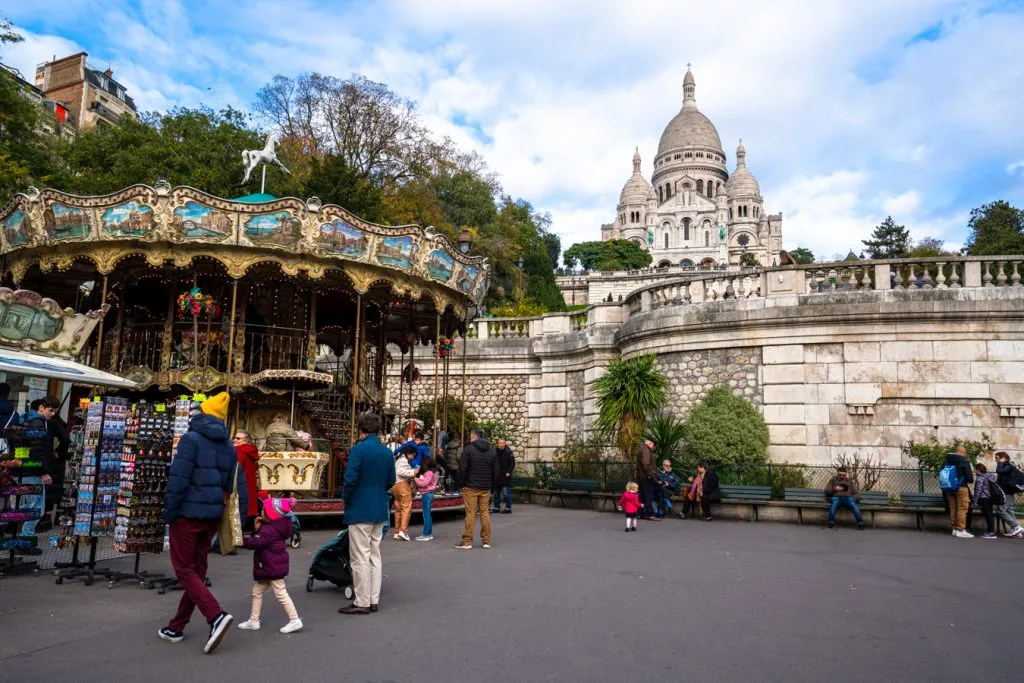
Proceed carefully if you want to have your portrait drawn in Montmartre.
I mentioned this when discussing the famous Place du Tertre, but it bears repeating: if you want to have your portrait drawn in Montmartre, choose your artist carefully!
An artist who is seated with an easel in the Place du Tertre is licensed and approved by the city, and is your best bet for quality work.
Don’t forget to discuss the price before committing!
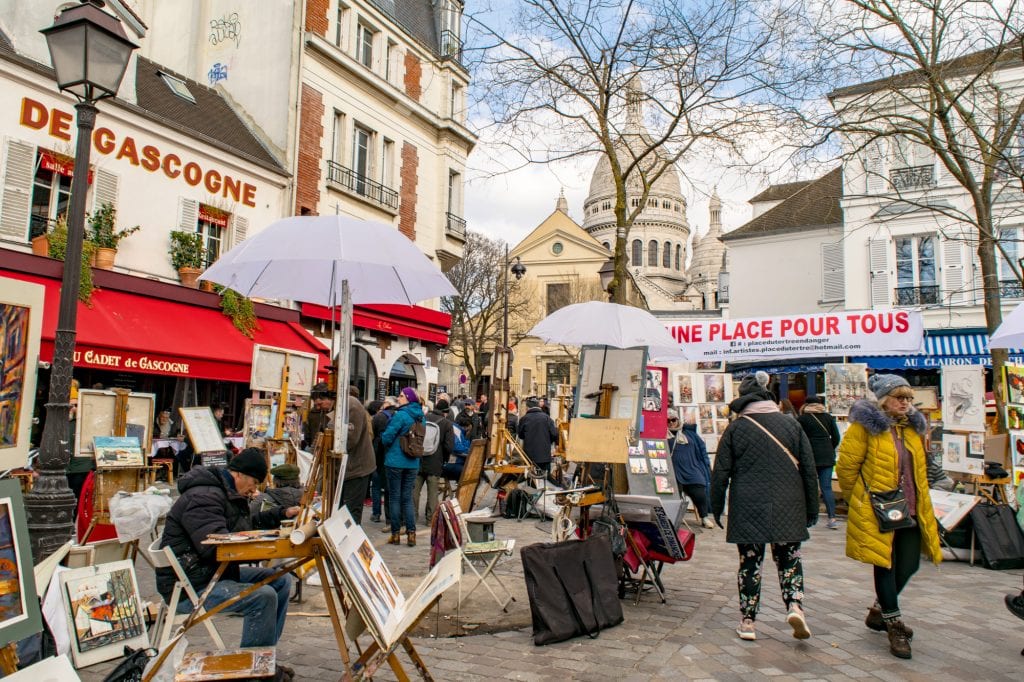
Consider visiting in the morning (or off-season) for the lowest crowds.
Generally speaking, a good rule of thumb for visiting Montmartre in Paris is that the earlier you arrive, the fewer crowds you’ll have to contend with.
If you are visiting Paris in the winter, then all the better: there’s far less congestion in Montmartre then.
Regardless, as one of the most popular neighborhoods to visit in Paris, it’s best to come to Montmartre expecting to be surrounded by tourists, souvenir hawkers, and more–unless, of course, you arrive at dawn.
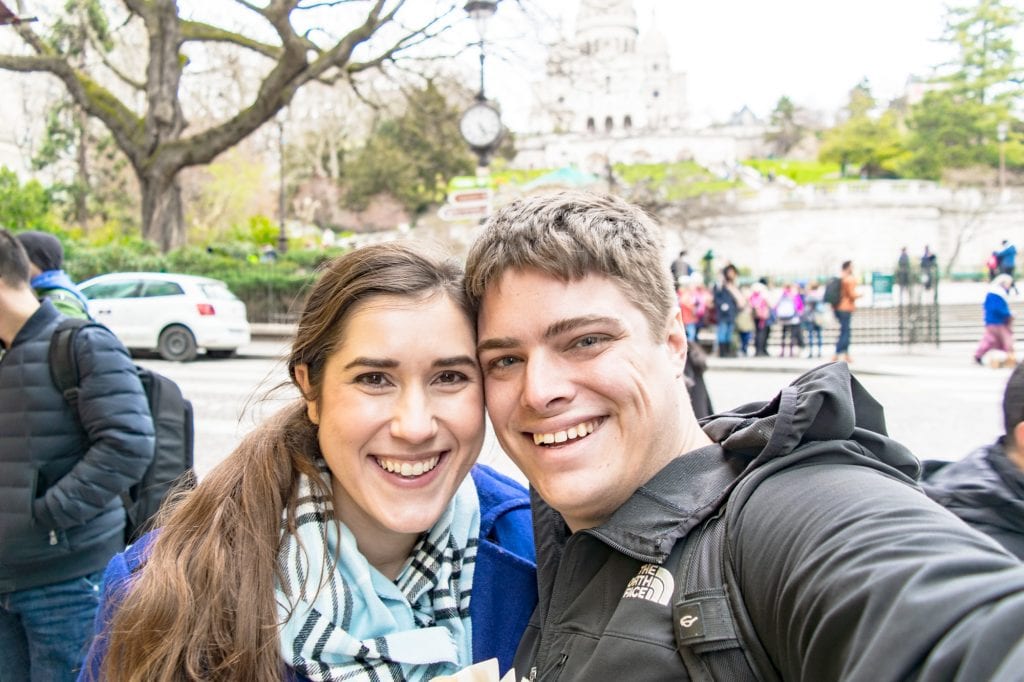
… but watching the sunset from Montmartre is also something special.
Watching the sun set over Paris from the butte of Montmartre is a beloved tradition in Paris and a fun addition to your trip!
The views are best from the top of Sacré-Coeur’s dome, but they’re still wonderful from the steps (you can’t see the Eiffel Tower from the steps, though).
Students, ex-pats, visitors, and more all gather into a jovial crowd to watch the sunset from the steps of the Sacré-Coeur every night, and it’s a memorable experience to join in the fun (just watch your pockets closely).
If you’d prefer a little more peace and quiet, wander around until you find one of the many smaller-but-still-magical viewpoints overlooking Paris.
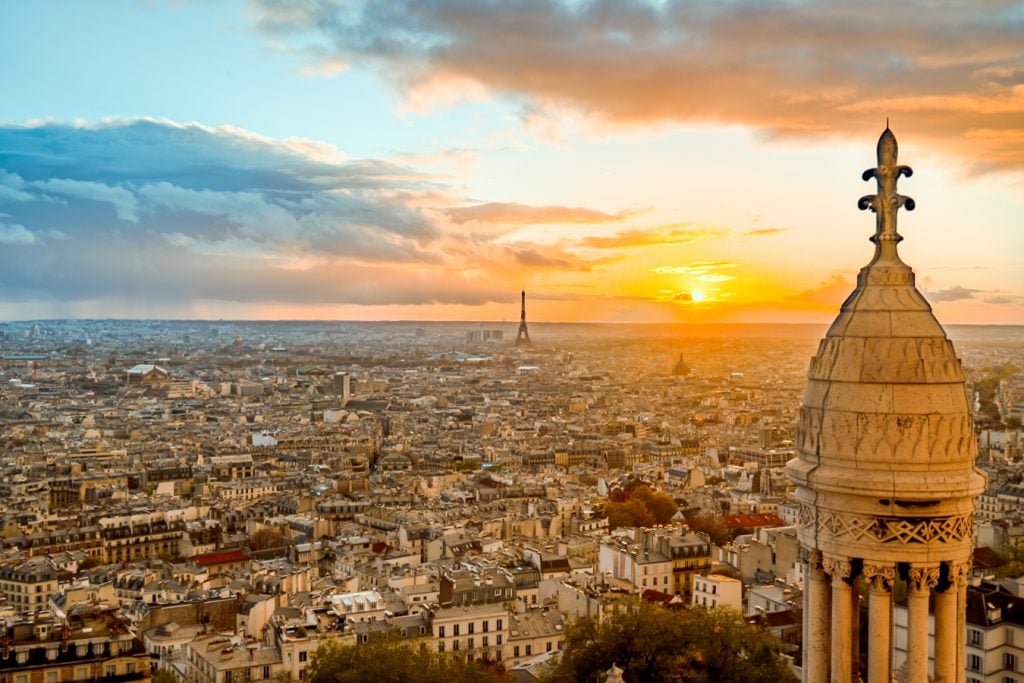
Don’t sit down at a restaurant without a quick check of its reviews.
In a place as popular with visitors as Montmartre, it’s inevitable that plenty of mediocre restaurants and cafes will pop up to serve them.
That’s not a reason to avoid eating in Montmartre at all, and we’ve enjoyed some lovely meals there (more on that in the FAQ section), but you’ll want to exercise the same caution here that you would when choosing restaurants near the Eiffel Tower or the Louvre.
Namely, avoid places that ask you to come inside, have a multi-lingual menu with flags printed on it out front, and (generally) that are within view of a major monument.
We like to use Google Reviews to check a place’s credentials before sitting down too–if you stick with places rated 4.1 and above, you’ll generally enjoy at least a solid (and sometimes delicious) meal without running into issues like surprise fees.

Self-Guided Montmartre Walking Tour Itinerary
Only have time for a short visit and want to enjoy as many of the best things to do in Montmartre as possible?
Here’s a quick Montmartre walking route that we have enjoyed variations of many times!
Starting from the Anvers metro stop, head up Rue de Steinkerque until you reach Place Saint-Pierre and its beautiful carousel and view of Sacré-Coeur.
Head further uphill (ideally by passing through Square Louise Michel, though you can take the funicular as well) to the steps of Sacré-Coeur.
Enjoy the view, head inside (it’s free!), and if you’re so inclined, climb the 300 steps to the top of the dome (it’s worth it).
Afterward, circle the basilica and pay a visit to Square Marcel Bleustein Blanchet.
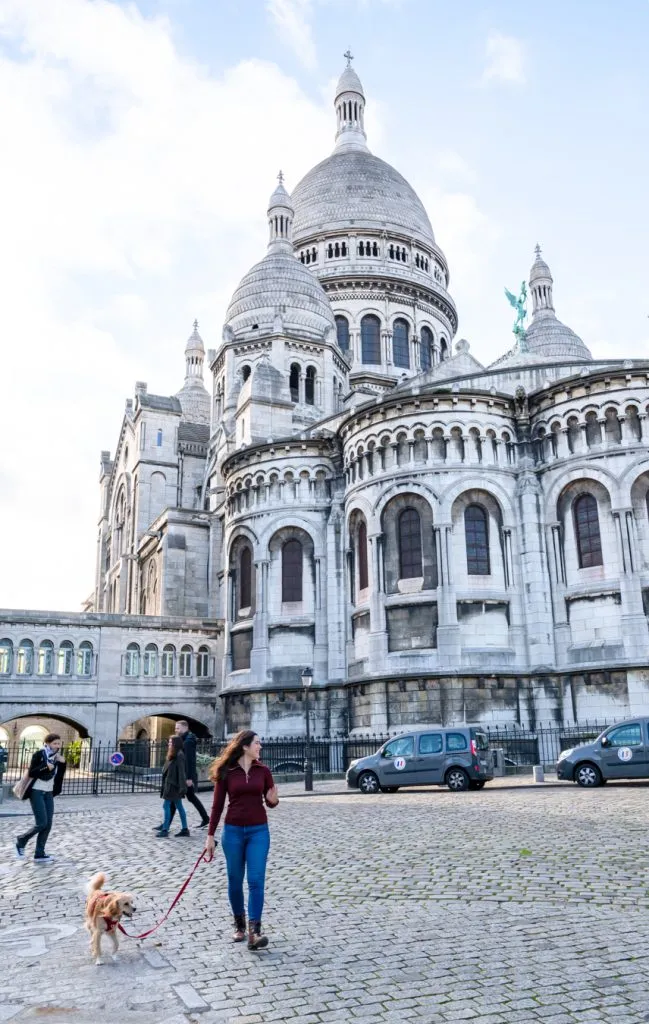
From there, finish encircling the church and head to the Place du Tertre, potentially ducking inside the Church of Saint-Pierre de Montmartre on your way.
Continue down Rue Norvins until you hit Le Consulat, and then right onto Rue des Saules.
In a very short time, you’ll come upon Le Clos Montmartre on your right.
Take a peek, then double back to La Maison Rose and stroll down the Rue de l’Abreuvoir until you hit Place Dalida (don’t forget to look behind you to enjoy the view!).
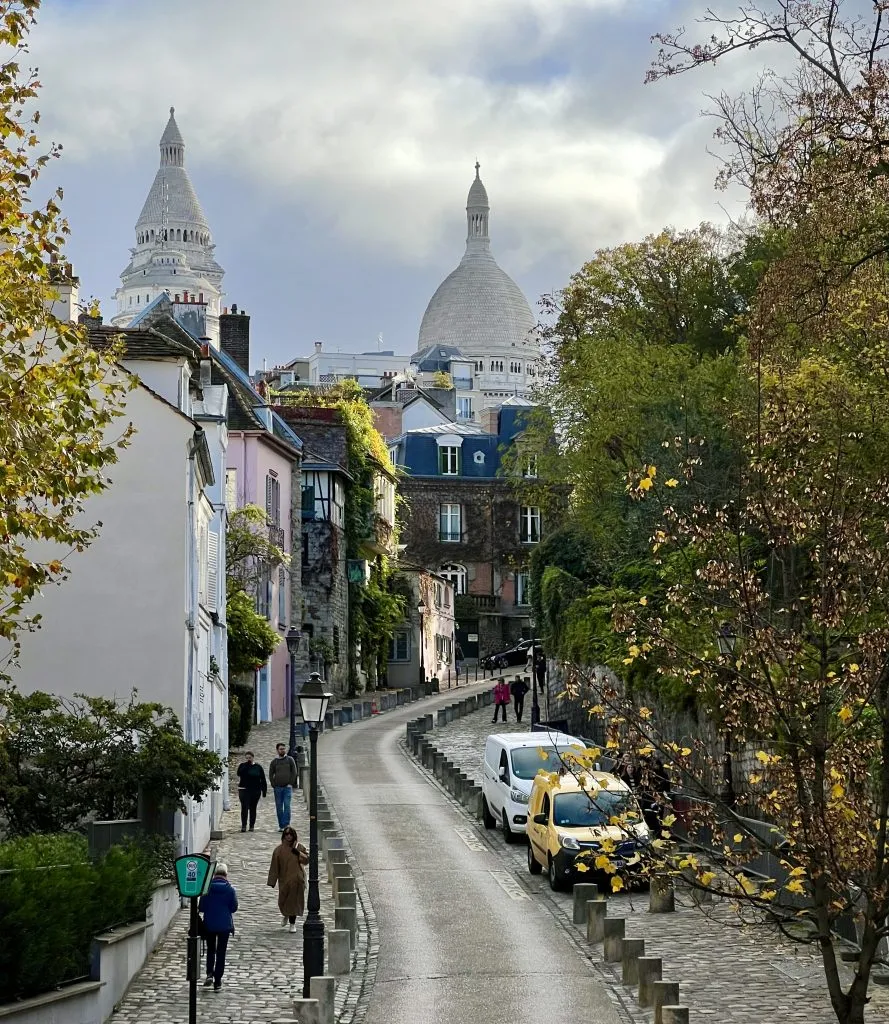
Head up Rue Girardon to famous Rue Lepic, and follow Rue Lepic as it curves back around and eventually meets up with Rue des Abbesses.
Right by the Abbesses metro stop, you’ll find the Wall of Love tucked inside Square Jehan Rictus (and right next to the metro stop, you’ll also find a crêperie stand that makes an excellent Nutella crepe).
From there, you can either hop on the metro and head off to another place in Paris, or double back to Rue Lepic and walk down to the Moulin Rouge (it’s about an 8-minute walk from the Wall of Love).
While this clearly doesn’t cover all of the beautiful places in Montmartre to visit, it’s an efficient way to get a memorable snapshot of Paris’ 18th arrondissement for those who may only have a few days in Paris and are working with limited time.
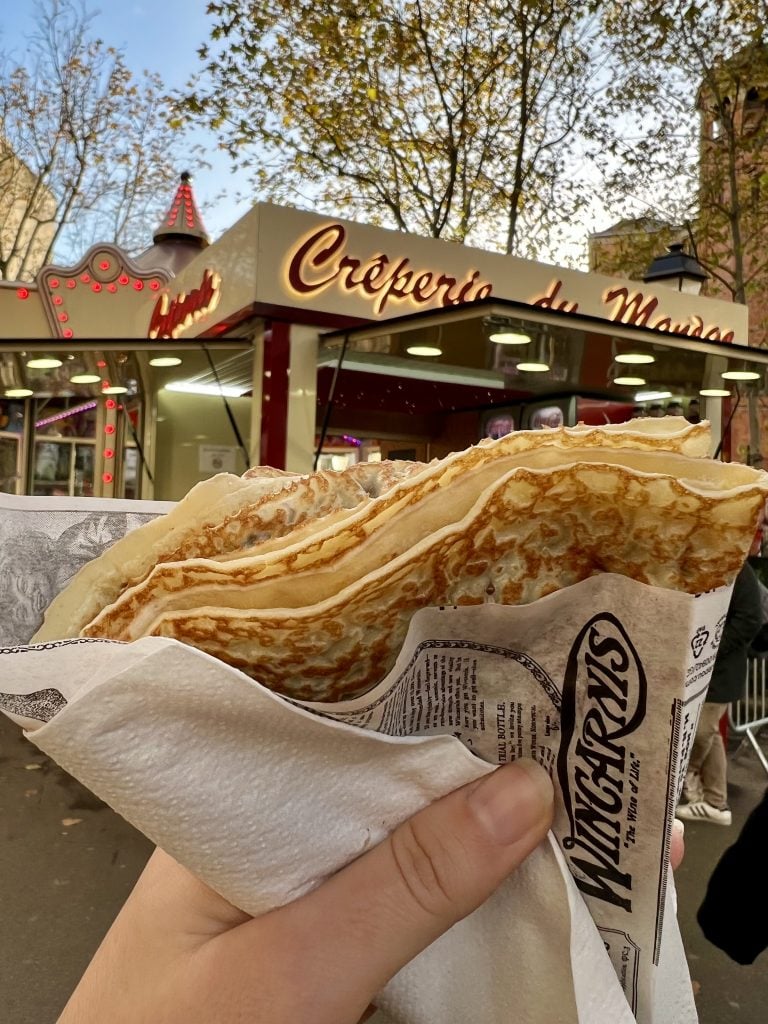
FAQ For Visiting Montmartre in Paris
What’s the best way to get to Montmartre?
We covered this in more detail in the how to get to Montmartre section of this blog post, but essentially, the easiest way to get to Montmartre is to take the metro.
You can either head to the Abbesses stop (Line 12), the deepest metro in Paris, and right next to the Wall of Love, or go to the Anvers stop (Line 2) and walk directly up Rue de Steinkerque from there until you dead-end into the Sacré-Coeur.
The Lamarck–Caulaincourt (Line 12) is another option on the north side of Montmartre, near Le Refuge.
If you want to see the Moulin Rouge on your way up, you could get off at the Pigalle stop and walk to Montmartre from there.
While there are a few other nearby metro stops and ways to access the neighborhood, Abbesses and Anvers are generally the most frequently used metro stops in/near Montmartre for visitors.
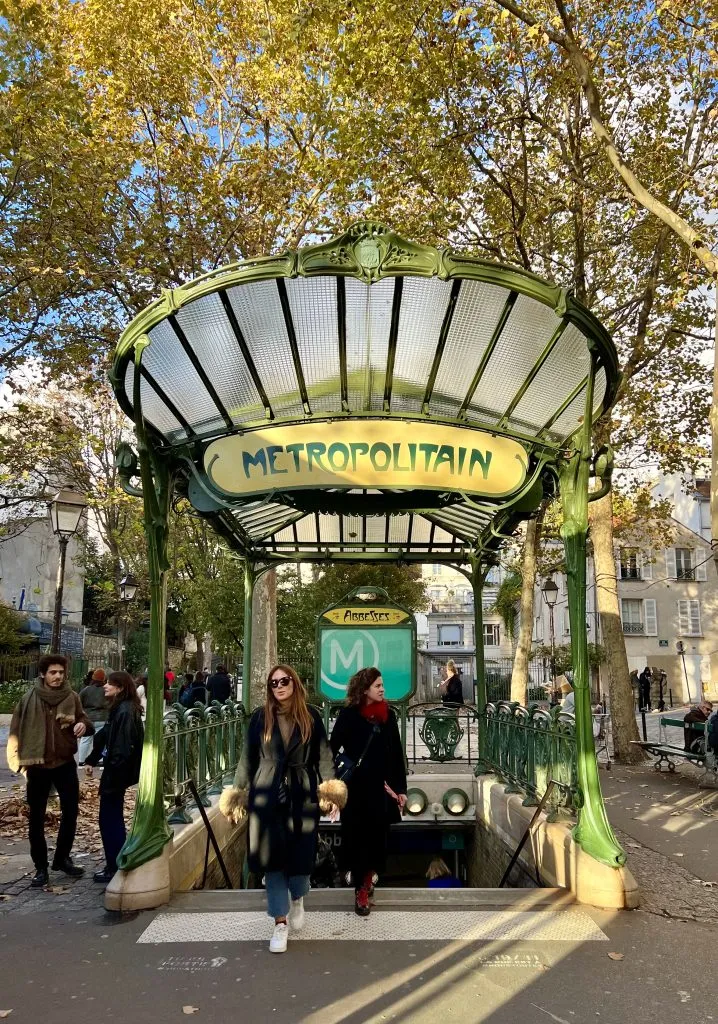
Where should I eat in Montmartre?
Montmartre has more than its fair share of mediocre restaurants aimed at tourists, so be sure to look up the reviews of anywhere you want to eat before you go!
For a special occasion, the Michelin Guide has some great suggestions!
For something unique, La Refuge des Fondus famously serves popular fondue at long, family-style tables–and serves their wine in baby bottles (yes, really).
Personally, we had tasty, casual lunches at Café de Luce and La Villa des Abbesses and would be happy to return to either.

For a quick bite, Fric-Frac gets wonderful reviews for their variety of croque-monsieurs.
And, don’t forget to stop by Pain Pain to sample a baguette that was once voted the best in Paris!
This barely scratches the surface of Montmartre restaurants, of course, but ultimately, just be sure to check the reviews of an eatery before sitting down.
And, like elsewhere in Paris, it’s best to either make reservations or show up at opening in order to have a good chance at getting a table (in the most popular or famous places, reservations are often a must).
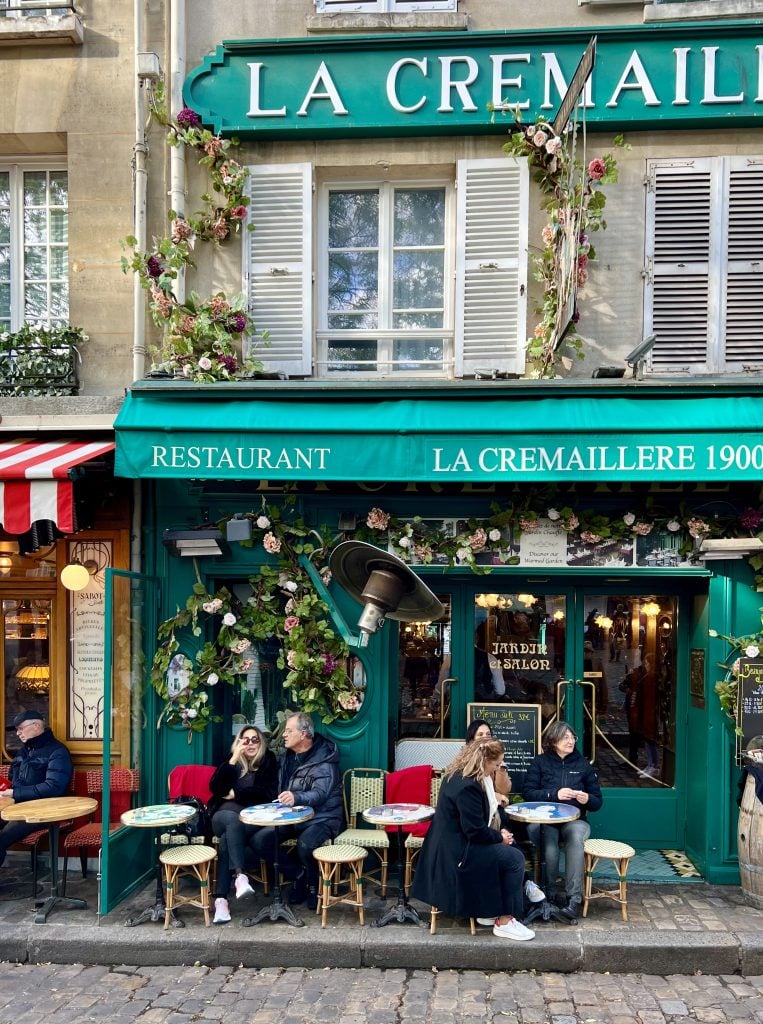
Is Montmartre a good place to stay in Paris?
It can be, depending on what kind of traveler you are!
Generally speaking, we would suggest that most first-time visitors to Paris choose a more centrally located neighborhood to stay in (the Latin Quarter (5e) or Saint-Germain-des-Prés (6e) fairly close to the Seine are our go-to suggestions).
However, if you’re a repeat visitor to Paris who loves Montmartre, or you’re hoping to save money by staying a bit further out, Montmartre can be a lovely option as long as you’re prepared to “commute” to most of the top things to do in Paris.
We’ve stayed in Montmartre twice, first in a Hotel Bellevue Montmartre (small rooms but adequate), and most recently at the Aparthotel Adagio Paris Montmartre, which we loved!
Keep in mind that as you leave the boundaries of Montmartre itself, the nearby Pigalle area (where the Moulin Rouge is) can be a bit louder due to the nightlife, as well as a bit less refined, so keep that in mind as you’re browsing places to stay in Montmartre.
Ateliers de Montmartre ADM and the Mom’Art Hotel are two well-reviewed properties we’d love to stay in during future trips to Montmartre.
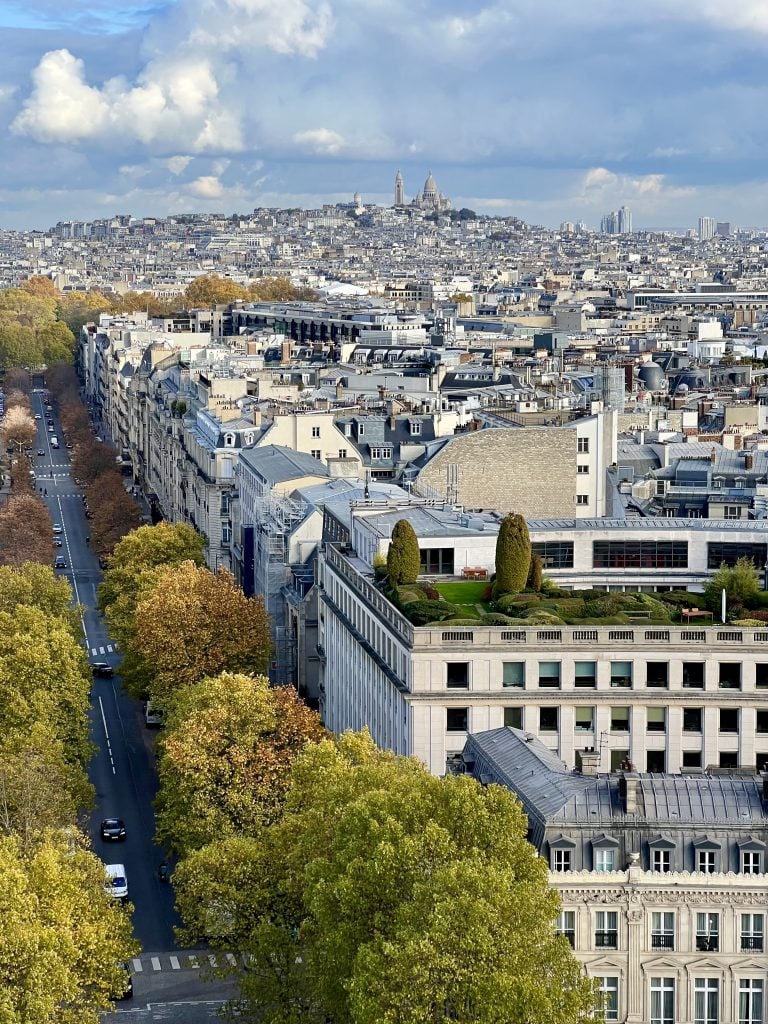
Is Montmartre worth visiting?
Yes, Montmartre is absolutely worth visiting!
Montmartre is one of Paris’ prettiest and most popular neighborhoods to visit and has been a favorite among visitors for generations.
While you’ll find more tourists than artists in this formerly bohemian neighborhood these days, that doesn’t mean it’s not still worth exploring–just that you’ll have to work a little harder to find quiet corners.
The most popular places to visit in Montmartre are typically popular for good reason, though, so don’t let the crowds scare you off (though maybe show up early to avoid the worst of them–more on that below).
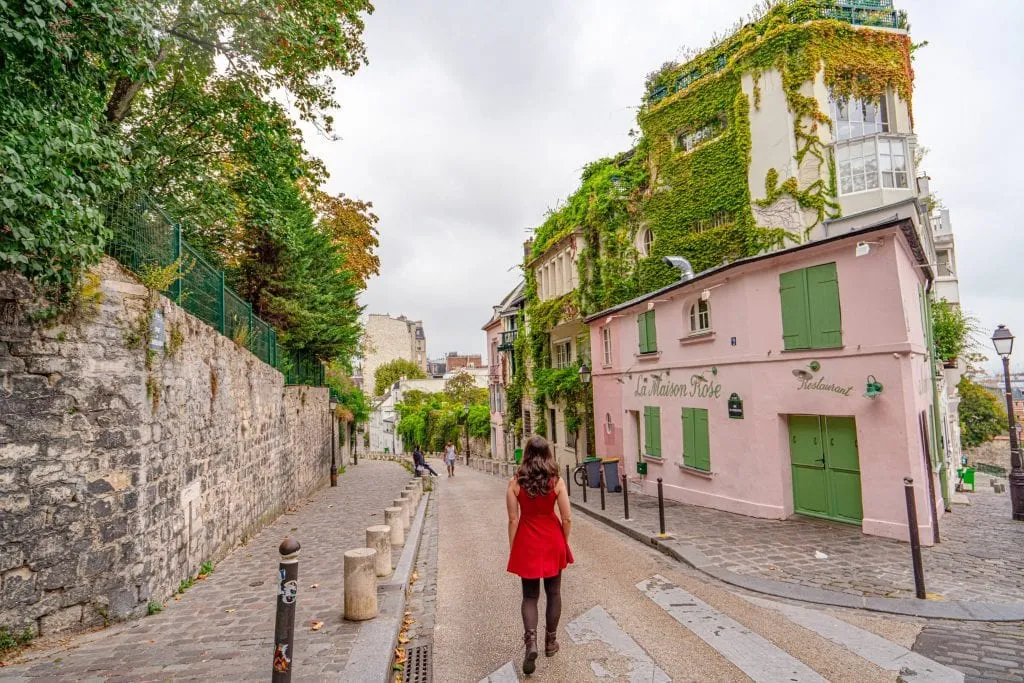
Is Montmartre safe?
When it comes to staying physically safe, Montmartre is generally as safe as any other tourist destination in Paris–which is to say, statistically very safe!
However, petty crime is a different story.
Pickpocketing is a problem in Montmartre, especially in places where tourists congregate in large crowds like the steps of Sacré-Coeur and the Place du Tertre.
Definitely keep an eye on your belongings, and don’t set your bag down at a cafe or restaurant in a place you can’t easily watch it (our favorite anti-theft backpack latches to chairs for a bit of extra safety).
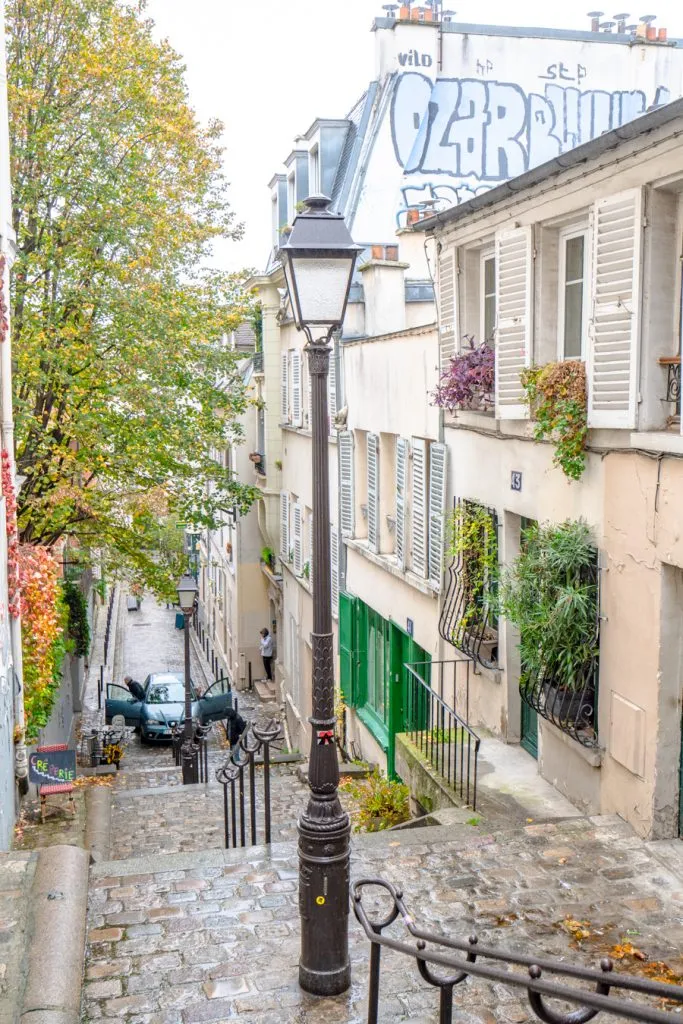
Scams are also an issue, but easily avoided: don’t give anyone money, and don’t accept any “free” items from touts (friendship bracelets are frequently offered).
A simple but firm “non, merci” and moving on is the best way to deal with a persistent tout.
We’ve never been pickpocketed, but it does happen and we do know people who have been robbed in Montmartre.
This is absolutely not a reason to avoid Montmartre, but staying aware of your belongings and surroundings is a must.
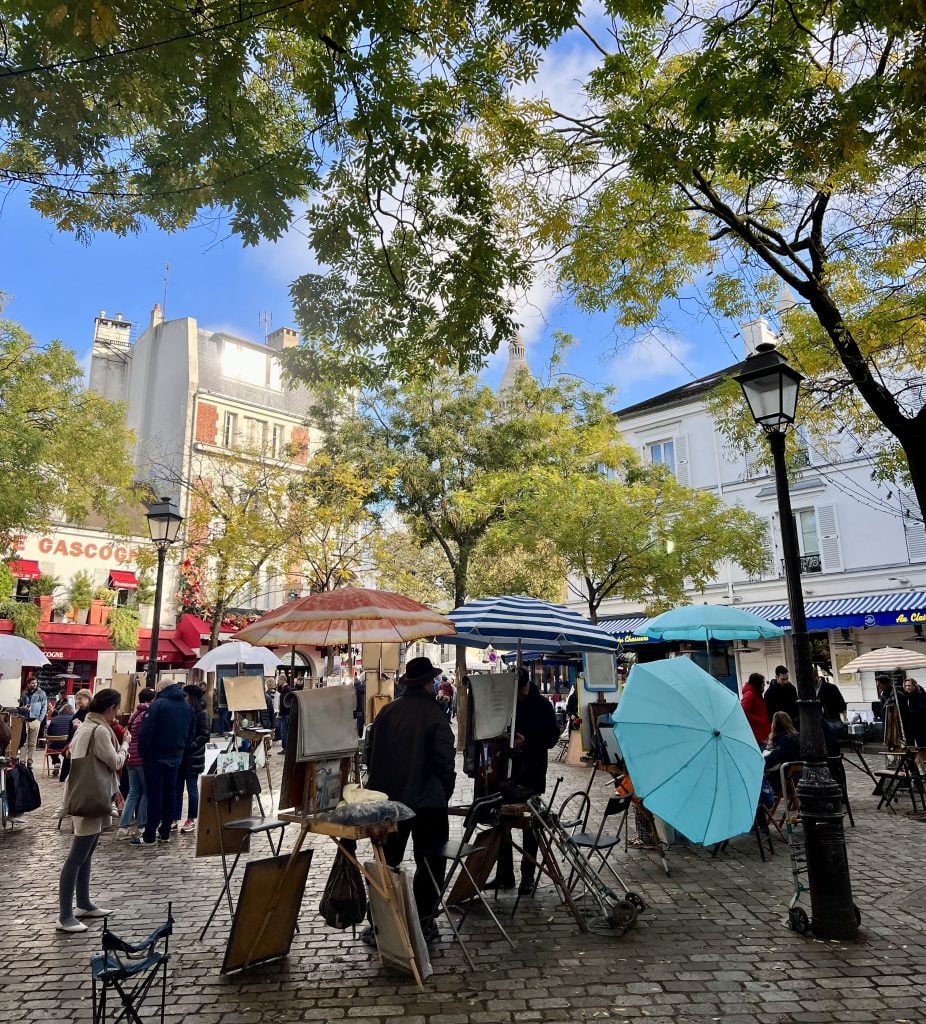
Is Montmartre safe at night?
Montmartre is very busy and touristy, and it’s generally considered just as safe at night as it is during the day!
You’ll want to be vigilant about common scams and pickpockets, but there’s no reason not to visit Montmartre at night.
Some of our favorite memories of visiting include enjoying Montmartre in the evening.
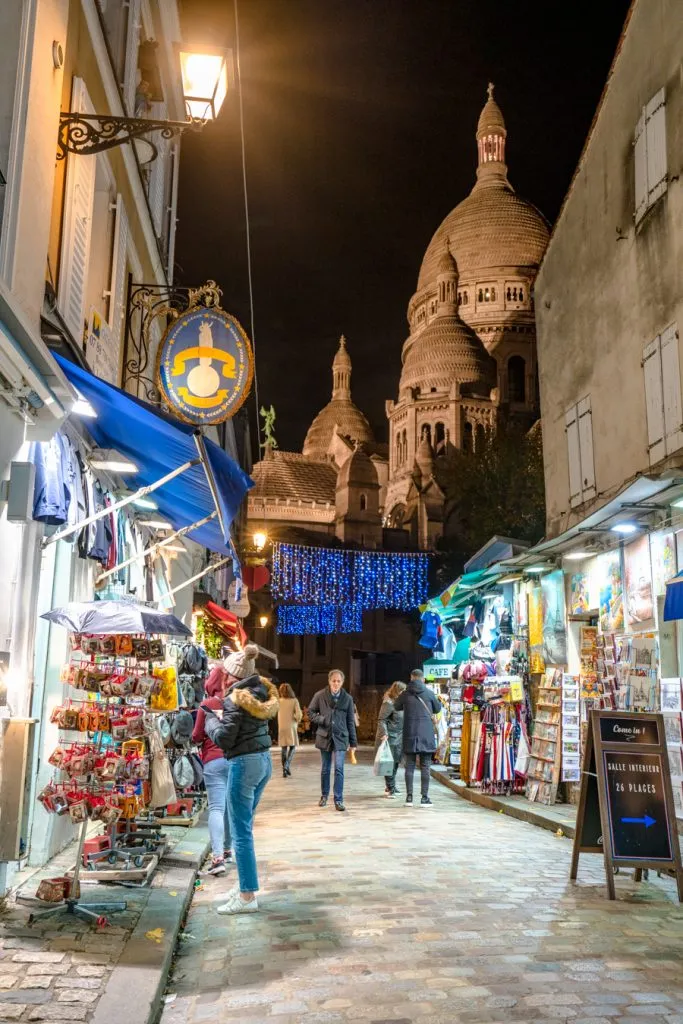
How long does it take to see Montmartre?
Our shortest visit to Montmartre lasted a couple of hours, and our longest visit was when we based ourselves in Montmartre (in this aparthotel, which we loved) for a week!
In other words, exploring the Montmartre neighborhood is very adaptable to however much time you do have.
Since it does take a bit of a time commitment to get there from the center of Paris, I’d recommend planning to spend at least 2 hours there to make the journey worth it.
If you have less time to spare than that, you’re probably better off enjoying one of the many other incredible things to do in Paris that are closer to the center–but then again, that depends on just how much you want to see even the tiniest sliver of Montmartre.
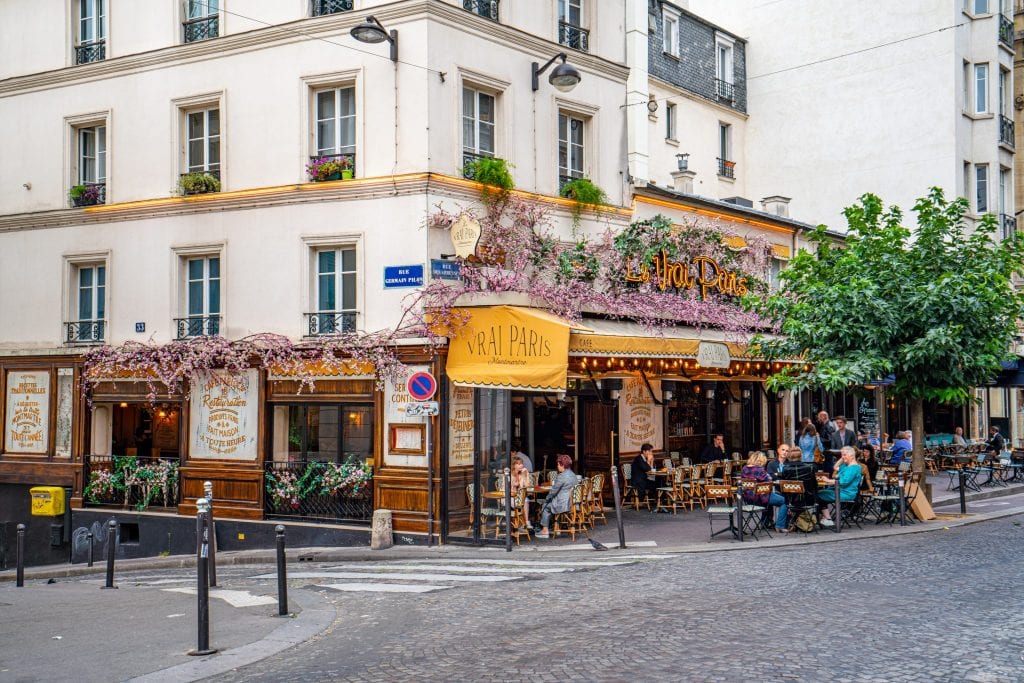
What’s the best time to visit Montmartre?
The most peaceful time to visit Montmartre is in the early morning, as soon after dawn as you can manage to get there!
Mornings generally have wonderful light for photography, too.
The most crowded time of day to visit Montmartre is the middle of the day and afternoon.
The evenings, including sunset, are far less peaceful than the mornings but are wonderful to experience.
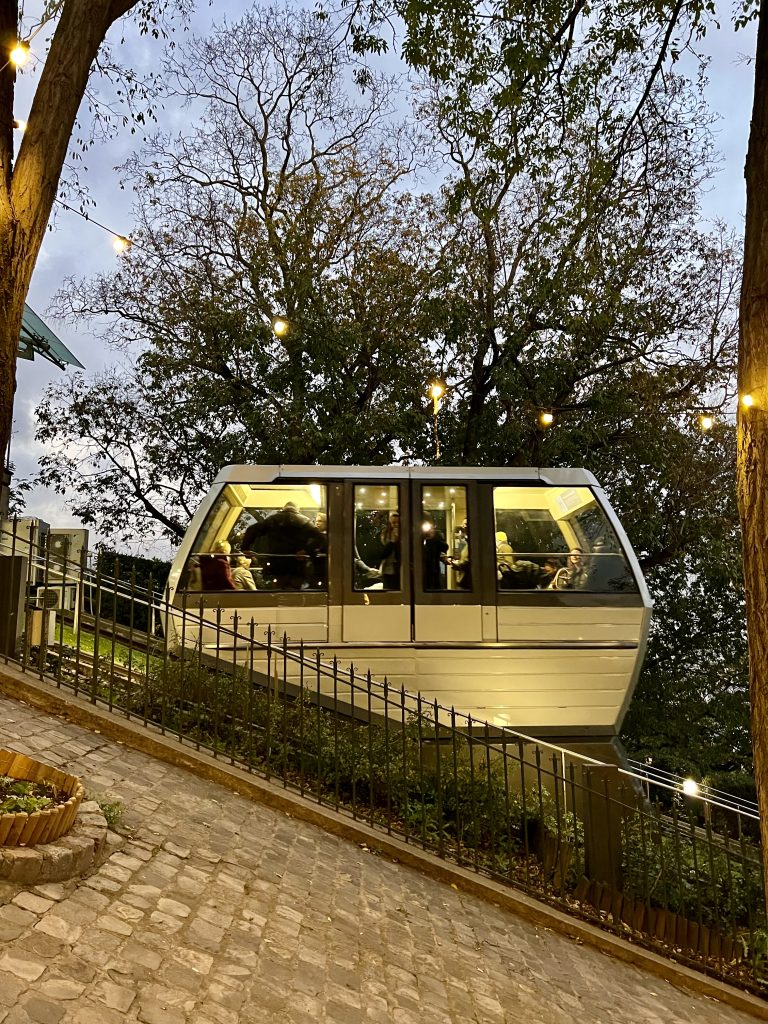
What’s the best month to visit Montmartre?
As far as the season goes, the crowds in the neighborhood of Montmartre follow those in the rest of Paris: summer is the busiest, winter the most empty, and spring and fall somewhere in the middle.
There’s not a single month of the year where I’d turn down a morning in Montmartre, though!
Cherry blossom season (late March to mid-April), fall foliage season (the first half of October), and Christmas market season (late November through early January) all also bring their own perks to the neighborhood.
Regardless of which month you visit, you’ll be able to enjoy all of the typical top things to do in Montmartre, Paris, plus perhaps some seasonal attractions as well!
Map of the Best Places to Visit in Montmartre
Take This Map With You! Click each highlight to pull up the name of the destination. To save this map to “Your Places” on Google Maps, click the star to the right of the title. You’ll then be able to find it under the Maps tab of your Google Maps account! To open the map in a new window, click the button on the top right of the map.

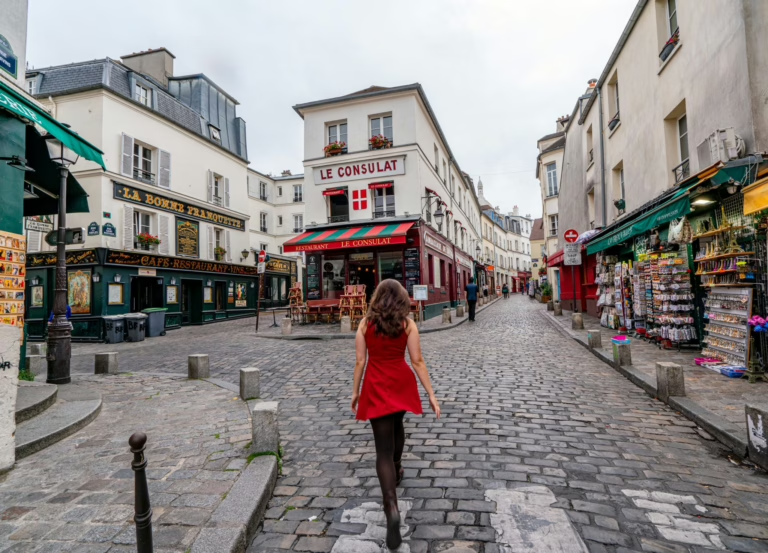
Do you have any suggestions for: Monte Carlo, Monaco, Marseille, France, Sete (Montpellier) France, & Barcelona, Spain? We will be taking a fall cruise and visiting these places each for a full day of 8 hours or more. Looking for options of what to see.
I really LOVE following you 2 and Ranger. Wishing you nothing but the BEST & HAPPINESS. Keep on traveling.
Hi Shari,
We’ve visited most of those, but not very in-depth for most of them (we have spent almost a week in Barcelona). We had the terrible luck of a rainy day when we were in Monaco, so didn’t get to see nearly as much of it as we would like!
I hope to publish a guide to spending one day in Barcelona sometime this spring, but in the meantime, I talk quite a bit about it in this post: https://www.ourescapeclause.com/10-days-in-spain-itinerary/
Thank you so much for following along with us! Wishing you and yours all the best. 🙂